A New Look at Cenozoic Fossil Wood from Thailand
Abstract
1. Introduction
2. Materials and Methods
3. Ban Tak Fossil Forest
3.1. Geologic Setting
3.2. X-ray Diffraction Data for Tak Fossil Wood
3.3. Microscopy of Tak Fossil Wood
4. Khorat Fossil Wood
4.1. Geologic Setting
4.2. Composition of Khorat Fossil Wood
4.3. Forms of Opal in Khorat Wood
4.4. Forms of Quartz in Khorat Fossil Wood
5. Wood Fossilization Processes
5.1. Tak Wood Fossilization
5.2. Khorat Plateau Wood Fossilization
6. Conservation Issues
Macroclimate and Microclimate Measurements
7. Conservation Methods: Tak Locality
7.1. Protective Shelters
7.2. Design Improvements for Shelters
7.3. Chemical Treatments
| Product | Chemical Component | Peformance Notes |
|---|---|---|
| CONSOLIDANT | ||
| PARALOID B-67 Dow Chemical Corporation, www.dow.com (accessed20 July 2022) | Paraloid B-67 is the most hydrophobic member of the Paraloid family of thermoplastic acrylic resins. It provides excellent water resistance in addition to its value as a consolidant. | Applied on log BT-7 during 2013–2014 tests. Coating is transparent, but with a slightly glossy surface. If the mixture ratio is not suitable. Brush application produces bubbles that are related to the porosity of the specimen. Limited depth of penetration made this product unsuitable as a consolidant. |
| PARALOID B-72 Dow Chemical Corporation, www.dow.com (accessed 20 July 2022) | Paraloid B-72 is an acrylic resin (ethyl-methacrylate copolymer) used as a consolidant or strong adhesive. Resin comes in solid pellets which are dissolved in an organic solvent for application. Acetone was used in our experiments. | Depth of penetration was 5–10 mm, too low for the resin to be an effective consolidant. SEM image show that the coating did not completely cover the porous wood surface, allowing water penetration. The glass transition temperature of 40 °C is reduced by acetone and other solvents, falling below common summer temperatures at Tak. Paraloid B-72 is often used for surface coating or as adhesive in conservation of glass, ceramic objects, and fossils stored indoor. However, it is not suitable for fossil Tak wood |
| SILRES BS-100 Wacker Chemical Corporation, www.wacker.com (accessed 20 July 2022) | Silres BS OH 100 is an alcoholic solution of ethyl silicate solution that penetrates porous stone. Reaction with water from atmospheric humidity or the moisture in the capillary pores causes a glass-like silica gel binder (SiO2.aq.) to form. The product does not contain any hydrophobic additives such as silanes or siloxanes, so it is a consolidant but not a water repellent. | This product was reasonably effective as a consolidant. A potential problem is the possible presence of soluble salts, which can reduce the effectiveness of ethyl silicate solutions. A positive attribute is that when they are applied properly, ethyl silicate consolidants are invisible on the specimen surface. A drawback is high cost. |
| Lime water | Aqueous calcium hydroxide solution | Application is by repeated spraying (up to 40 times for architectural applications). Lime water penetrates into porous stone to produce a strengthened layer. This zone remains permeable to water vapor, allowing trapped moisture to escape. Lime was most effective for fossil wood samples that had relatively low porosity interconnecting pores. Less protection was observed for samples with high porosity and large-diameter pores. The surface appearance of treated specimens was only slightly altered. |
| WATER REPELLENT | ||
| RHOXIMAT RC-80 with HD224 RhodiaChimie (BolognepBillancourt Cedex, France | Ethyl silicate and poly-methyl-siloxane in alcohol solvent. Diluted 1:1 for application. | This product performed very well for reduction in water absorption (99.5%), while maintaining 86–88% permeability to water vapor. |
| SILRES BS SMK 1311 Wacker Chemical Corporation, www.wacker.com (accessed 20 July 2022) | This product is a microemulsion concentrate containing silanes and siloxanes. It is diluted with water for application. Silanes and siloxanes are susceptible to hydrolysis that occurs only after application to the substrate. The emulsion is converted into a silicone resin water repellent. | Silicone microemulsions were found to be the most efficient of the products tested, providing a high degree of water repellency. Visual observations revealed that treated samples did not change color. SEM images confirmed that the tested water repellents did not block the pores of the petrified wood. For both Silres products, the water absorption of treated test pieces is considerably lower than for untreated test pieces. A disadvantage of these products is high cost. |
| SILRES BS 4004 Wacker Chemical Corporation, www.wacker.com (accessed 20 July 2022) | This emulsion contains a stabilized mixture of silanes and siloxanes. | |
| RESTORATION FILLER | ||
| Lime mixed by hand with water and sand to make a viscous paste | Mixture 1: Slaked lime and coarse sands mixed in a volume ratio of 1: 3 Mixture 2: Slaked lime and fine sand mixed in a volume ratio of 1: 3 Mixture 3: Slaked lime and fine sand mixed in a volume ratio of 1:4 Mixture 4: Slaked lime and mixed size fine sand with a lime/sand volume ratio of 1:3 | Mixing of lime, sand, and water produce an inexpensive material for filling fractures and open spaces on fossil logs. The mixtures can be tinted with iron oxides, brick powder or other inorganic pigments to provide an approximate color match (Figure 25). The physical properties of sand affect the plasticity of the paste and the hardness of the final material. Fine sand increases adhesion and workability, but the lime/sand mix has greater shrinkage during curing and lower ultimate strength. Conversely, lime mixed with medium and coarse sands have lower shrinkage, but with a reduction in workability. In all cases, the sand should be clean with irregular grain shapes (e.g., angular rather than well-rounded). Poorly-sorted sands (mixed sands) produce intermediate results between fine and coarse sand mixtures, and they may be a useful alternative. Mixed sand gives better strength than coarse sand. However, coarse sand and mixed sand in the mixtures decreases the water absorption of the hardened mixtures. Mixtures of lime and coarse sand can be used to fill large cavities. Smaller flaws can be filled using lime with fine or medium sand. Lime/coarse sand mixtures have greater compressive strength than lime/fine sand mixtures. Vapor permeability is related to the porosity and median pore diameter (MPD) and median pore volume (MPV) of the hardened lime/sand mix. Mercury porosity measurements were used to provide quantitative evaluations. For example, 1:3 lime/coarse sand had a MPD of 1 × 10−17 m compared to 9 × 10−18 m for 1:3 lime/fine sand. The MPV for the line/coarse sand mixture was 6.34 × 10−16 m2, and 2.893 × 10−10 m2 for the fine sand/lime mix. These data show that although the lime/fine sand mix has smaller pore diameter, the overall porosity is greater than for the line/coarse sand paste. |
7.4. Overview of Experimental Chemical Treatments
7.5. Administrative Actions
8. Conservation Strategies: Khorat Locality
9. Conclusions
Author Contributions
Funding
Data Availability Statement
Acknowledgments
Conflicts of Interest
References
- Choowong, M. Quaternary. In Geology of Thailand; Ridd, M.F., Barber, A.J., Crow, M.J., Eds.; The Geological Society: London, UK, 2011; pp. 335–350. [Google Scholar]
- Mustoe, G.E. Density and Loss on Ignition as Indicators of Silicified Wood. IAWA J. 2016, 37, 98–111. [Google Scholar] [CrossRef]
- Songtham, W.; Mildenhall, D.C.; Ratanasthien, B. Petrified Tree Trunks from a Gravel Deposit, Ban Tak Petrified Forest Park, Ban Tak-Sam Ngao Basin, Tak Province, Northern Thailand. J. Sci. Technol. MSU 2012, 31, 93–100. Available online: https://www.thaiscience.info/Journals/Article/JSMU/10887847.pdf (accessed on 20 July 2022).
- Boonchai, N.; Grote, P.J.; Jintasakul, P. Paleontological Parks and Museums and Prominent Fossil Sites in Thailand and Their Importance in the Conservation of Fossils. In PaleoParks–The Protection and Conservation of Fossil Sites Worldwide; Lipps, J.H., Granier, B.R.C., Eds.; Carnets de Géologie/Notebooks on Geology: Brest, France, 2009; Chapter 07; pp. 75–95. [Google Scholar]
- Geological Survey Division, Department of Mineral Resources. Geological Map of Thailand, Changwat Uttaradit 1: 250,000 Bangkok Thailand; Geological Survey Division, Department of Mineral Resources: Bangkok, Thailand, 1974.
- Suskem, W. Feldspar in Tak Province. Technical Report on Economic Geology No. 211534; Department of Mineral Resources: Arcadia, CA, USA, 1992.
- Saseda, M.; Ratanasthien, B.; Suponpongpipat, R. New K/Ar Ages from the Lampang Basalt, Northern Thailand. Geol. Surv. Jpn. Bull. 1987, 38, 13–20. [Google Scholar]
- Won-In, K.; Singtuen, V. Geoheritage Conservation for Sustainable Geotourism in Petrified Wood Forest Park, Tak Province, Thailand. Turk. Online J. Des. Art Commun–TOJDAC ISSN 2146-5193. 2018, 1, 1532–1537. Available online: http://tojdac.org/tojdac/VOLUME8-SPTMSPCL_files/tojdac_v080SSE205.pdf (accessed on 29 March 2022).
- Saminpanya, S. Mineralogy of Petrified Trees in the Petrified Forest Park, Tak Province, Thailand. In Proceedings of the Geological Society of America Annual Meeting, Indiana, IN, USA, 7 November 2018; Volume 50. Available online: https://gsa.confex.com/gsa/2018AM/webprogram/Paper316397.html (accessed on 25 June 2022).
- Aranyanark, C. A Research Summary of Petrified Trees Conservation Methodology; National Geographic Society: Bangkok, Thailand, 2018; 11p, unpublished. [Google Scholar]
- Boonchai, N.; Samingpanya, S.; Aranyanark, C.; Suteethorn, S. Research on Conservation Methodology of the World’s Longest Petrified Tree in the Petrified Forest Park, Tak Province; Final Report Project no. P-16-51513; National Science and Technology Development Agency (NSTDA): Bangkok, Thailand, 2019; 217p, submitted.
- Yang, F.-C.; Grote, P.J. Riverine Vegetation and Environment of a Late Pleistocene River Terrace, Khorat Plateau, Southeast Asia. Palynology 2017, 42, 158–167. [Google Scholar] [CrossRef]
- Meesook, A.; Saengsrichan, W. Jurassic. In Geology of Thailand; Ridd, M.F., Barber, A.J., Crow, M.J., Eds.; The Geological Society: London, UK, 2011; pp. 151–168. [Google Scholar]
- Meesook, A. Cretaceous. In Geology of Thailand; Ridd, M.F., Barber, A.J., Crow, M.J., Eds.; The Geological Society: London, UK, 2011; pp. 169–184. [Google Scholar]
- Högbom, B. Contributions to the Geology and Morphology of Siam. Bull. Geol. Inst. Univ. Upps. 1913, 12, 56–128. [Google Scholar]
- Colani, M. Sur Quelques Araucarioxylo nindochinoi. Bull. Du Serv. Geol. De L’inochine 1919, 6, 5–15. [Google Scholar]
- Asama, K. Some Younger Mesozoic Plants from the Lom Sak Formation, Thailand. Geol. Palaeontol. South-East Asia 1973, 13, 39–46. [Google Scholar]
- Asama, K. Araucarioxylon from Khorat, Thailand. Geol. Palaeontol. Southeast Asia 1982, 23, 57–64. [Google Scholar]
- Philippe, M.; Suteethorn, V.; Lutat, P.; Buffetaut, E.; Cuny, C.L.; Barale, G. Stratigraphical and Palaeobiogeographical Significance of Fossil Wood from the Mesozoic Khorat Group of Thailand. Geol. Mag. 2004, 141, 319–328. [Google Scholar] [CrossRef]
- Prakash, U. Fossil Dicotyledonous Woods from the Tertiary of Thailand. Palaeobotanist 1979, 26, 50–62. [Google Scholar]
- Wang, Y.; Zhang, W.; Zheng, S.; Jintasakul, P.; Grote, P.; Boonchai, N. Recent Advances in the Study of Mesozoic-Cenozoic Petrified Wood from Thailand. Prog. Nat. Sci. 2006, 16, 501–506. [Google Scholar] [CrossRef]
- Sangsuk, W. Petrification of Woods in the Tha Chang Sand Pit, Nakhon Ratchasima Province. Master’s Thesis, Chiang Mai University, Chiang Mai, Thailand, 2008; 166p. [Google Scholar]
- Mustoe, G.E. Late Tertiary Petrified Wood from Nevada, USA: Evidence of multiple silicification pathways. Geosciences 2015, 5, 286–309. [Google Scholar] [CrossRef]
- Mustoe, G.E. Calcite-mineralized fossil wood from Vancouver Island, British Columbia, Canada. Geosciences 2021, 11, 38. [Google Scholar] [CrossRef]
- Mustoe, G.E. Wood Petrifaction: A New View of Mineralization and Replacement. Geosciences 2017, 7, 119. [Google Scholar] [CrossRef]
- Leo, R.F.; Barghoorn, E.S. Silicification of Wood, Harvard University Botanical Museum. Leaflets 1973, 25, 1–48. Available online: https://www.jstor.org/stable/41762773 (accessed on 20 June 2022).
- Murata, K.J. Volcanic Ash as a Source of Silica for the Silicification of Wood. J. Sci. 1940, 238, 586. [Google Scholar] [CrossRef]
- Matsova, P.; Röβler Götze, J.; Leichmann, L.; Forbes, C.; Taylor, E.J.; Sakala, L.; Grygar, T. Alluvial and Volcanic Pathways to Silicified Plant Stems (Upper Carboniferous-Triassic) and Their Taphonomic and Palaeoenvironmental Meaning. Palaeogeogr. Palaeoclimatol. Palaeoecol. 2010, 292, 127–143. [Google Scholar] [CrossRef]
- Pailoplee, S.; Charusiri, P. Seismic Hazards in Thailand: A Compilation and Updated Probabilistic Analysis. Earth Planets Space 2016, 98, 1–14. [Google Scholar] [CrossRef][Green Version]
- Ornthammartah, T.; Warnitcha, P.; Workanchana, K.; Zarman, S.; Sigbjöornsson, R.; Lai, G.C. Probabilistic Seismic Hazard Assessment of Thailand. Bull. Earthq. Eng. 2014, 9, 367–394. [Google Scholar] [CrossRef]
- Mustoe, G.E.; Acosta, M. Origin of petrified wood color. Geosciences 2016, 6, 25. [Google Scholar] [CrossRef]
- Kyriazi, E. Matter and Materials in/for Heritage Conservation. In Proceedings of the MATCONS 2019, Craiova, Romania, 7–12 October 2019; pp. 11–30. [Google Scholar]
- Kryaizi, E.; Zacharias, N.; Palamara, E.; Boonchai, N. Preliminary SEM-EDS Observations Present on Petrified Wood Samples from Possibly the World’s Longest Fossil Tree. In Proceedings of the 4th ARCH_RNT Symposium on Archaeometry, International Institute for Conservation of Historic and Artistic Works, Kalamata Greece, 1–3 October 2020; pp. 92–104. [Google Scholar]
- Kyriazi, E.; Zouros, N. Conservation Training at Lesvos Petrified Forest. News Conserv. 2009, 12, 6. [Google Scholar] [CrossRef]
- Young, J.L.; Meyer, H.W.; Mustoe, G.E. Conservation of an Eocene Petrified Forest at Florissant Fossil Beds National Monument: Investigation of strategies and techniques for stabilizing in situ fossil stumps. In Paleontology of the Upper Eocene Florissant Formation Special Paper; Meyer, H.W., Smith, D.M., Eds.; Colorado, Geological Society of America: Boulder, CO, USA, 2008; pp. 141–157. [Google Scholar] [CrossRef]
- Oxland, E. Conservation Assessment and Experimental Mechanical Pinning Treatment of Petrified Sequoia Affinis Stumps at Florissant Fossil Beds National Monument, Colorado. Master’s Thesis, University of Pennsylvania, Philadelphia, PA, USA, 2017. Available online: https://repository.upenn.edu/hp_theses/630/ (accessed on 23 July 2022).
- Livesey, C.S. Formulation and Evaluation of a Biophyllic Protective Surface Treatment for Stone Substrates. Master’s Thesis, Historic Preservation Program, University of Pennsylvania, Philadelphia, PA, USA, 2022; 87p. [Google Scholar]
- Kázmér, M. The Miocene Bükkábrány Fossil Forest in Hungary–field observations and project outline. In 125th Anniversary of the Department of Palaeontology at Budapest University–A Jubilee; Galácz, A., Ed.; Department of Palaeontology at Budapest University: Budapest, Hungary, 2008; Volume 6, pp. 229–244. [Google Scholar]
- Kyriazi, E.; Boonchai, N.; Gray, R.; Gawee, S.; Zacharias, N. The Petrified Forest of Tak, Thailand–new challenges for the Science of Conservation. In Proceeding of the Conservation of Cultural Heritage–Challenges and Reviews, Athens, Greece, 25–39 May 2015; pp. 11–32. [Google Scholar]
- Kyriazi, E. Analytical Techniques and Observation Tools for the Diagnosis of the Pathology of in Situ Fossil Forests. In Diagnosis, before, during, after, Conservation 360, No. 2; Villa, A., Murray, A., Eds.; Unversitat Politècnica de València: València, Spain, 2022; pp. 1–21. Available online: https://monografias.editorial.upv.es/index.php/con_360/article/view/398 (accessed on 20 July 2022).
- Ganning, B.; Wulff, F. The Effects of Bird Droppings on Chemical and Biologic Dynamic in Brackish Water Pools. Oikos 1969, 20, 274–281. [Google Scholar] [CrossRef]
- Charola, A.E. Salts in the Deterioration of Porous Materials: An Overview. J. Am. Inst. Conserv. 2000, 39, 327–343. [Google Scholar] [CrossRef]
- Doehne, E. Salt Weathering: A Selective Review. In Natural Stone, Weathering Phenomena, Conservation Studies, Case Studies; Siegesmund, S., Weiss, T., Volbretcht, A., Eds.; Geological Society Special Publication: London, UK, 2002; pp. 31–64. [Google Scholar]
- Richards, J.M. The Weathering of Concrete. Archit. J. 1957, 20, 911–913. [Google Scholar]
- Bonnington, J.S. The Weathering of Concrete; The Concrete Society: London, UK, 1971; 66p. [Google Scholar]
- Research and Creative Design Center. Report of Contract Services for Methods of Conservation and Physical Weathering Pre-Vention of The Registered Petrified Wood Site at Mai Klai Pen Hin National Park; Tak Province, Department of Mineral Resources Ministry of Natural Resources and Environment: Tak, Thailand, 2019; 122p.
- Horie, V. Materials for Conservation: Organic Consolidants, Adhesives, and Coatings; Butterworth-Heinemman: Oxford, UK, 1987; pp. 103–112. [Google Scholar]
- Podeny, J.; Garland, K.; Rogers, F.H. Paraloid B-72 as a Structural Adhesive and as a Barrier Within Structural Adhesive Bonds: Evaluations of Strength and Reversibility. J. Am. Inst. Conserv. 2001, 40, 15–33. [Google Scholar] [CrossRef]
- Vinçotte, A.; Beavoit, E.; Boyard, N.; Guilminot, E. Effect of Solvent on PARALOID® B72 and B44 Acrylic Resins used as Adhesives in Conservation. Herit. Sci. 2019, 7, 1–9. [Google Scholar] [CrossRef]
- Forster, A.M.; Szadurski, E.M.; Banfil, P.F.G. Deterioration of Natural Hydraulic Lime Mortars, I. Effects of Chemically Accelerated Leaching on Physical and Mechanical Properties of Uncarbonated Materials. Constr. Build. Mater. 2014, 72, 199–207. [Google Scholar] [CrossRef]
- Lucian, C. Characterization of Mortar Deterioration in Historic Buildings in Bogomayo, Tanzania. Int. J. Eng. Adv. Technol. Stud. 2015, 3, 1–12. [Google Scholar]
- Guerra, F.L.; Lopes, W.; Cazaralli, J.V.; Lobata, F.L.; Masuero, A.B.; Dal Malin, D.C.C.; Bento, F.M.; Schrank, A.; Vainstein, M.H. Biodeterioration of Mortar Coating in Historic Buildings: Microclimatic Characterization, Material, And Fungal Community. Build. Environ. 2019, 155, 195–209. [Google Scholar] [CrossRef]
- UNESCO, UNESCO Global Geoparks (UGGp). 2015. Available online: https://en.unesco.org/global-geoparks (accessed on 22 July 2022).
- Boonchai, N.; Naksri, W.; Gray, R.J.; Jintasakul, P. Petrified Forest, Tak Province, sustainable conservation and economic de-velopment from community-based natural resource management. In Proceedings of the 3rd National Meetingon Biodiversity Management in Thailand, Nan, Thailand, 15–17 June 2016; pp. 40–47. [Google Scholar]
- Harnpattanapanich, T.; Luddakul, A. Seismic hazard of the Khorat Plateau: A preliminary review. In Proceedings of the International Conference on Geology, Geochronology, and Mineral Resources of Indochina (GEOINDIO 2011), KhonKaen, Thailand, 1–3 December 2011; pp. 457–461. [Google Scholar]
- Phiancharoen, C. Interpretation of the Chemical Analysis of Ground Water of the KhoratPlateau, Thailand. Master’s Thesis, Arizona State University, Tempe, AZ, USA, 1962. [Google Scholar]
- LaMoreaux, P.E.; Charaljavanaphet, J.; Jaliche, N.; Chiengmai, J.E.N.; Bunnag, P.; Thavisiru, A.; Rakprathum, C. Reconaissance of the Geology and Groundwater of the Khorat Plateau, Thailand U.S, Paper 1429; Geological Survey Water Supply: Washington, DC, USA, 1958; 76p.
- Pentamwa, O.; Thipthara, W.; Nuangon, S. Removal of Hardness from Groundwater by Synthetic Resin from Plastics. Int. J. Environ. Sci. Dev. 2011, 2, 479–483. [Google Scholar] [CrossRef]
- Nueston, F.M. Stain Removal Guide for Stone. U.S. General Services Administration Procedure Code 4455275. 2017. Available online: https://www.gsa.gov/technical-procedures/cleaning-historic-masonry-removal-atmospheric-soiling-stains-and-biological?Form_Load=88070 (accessed on 4 July 2022).
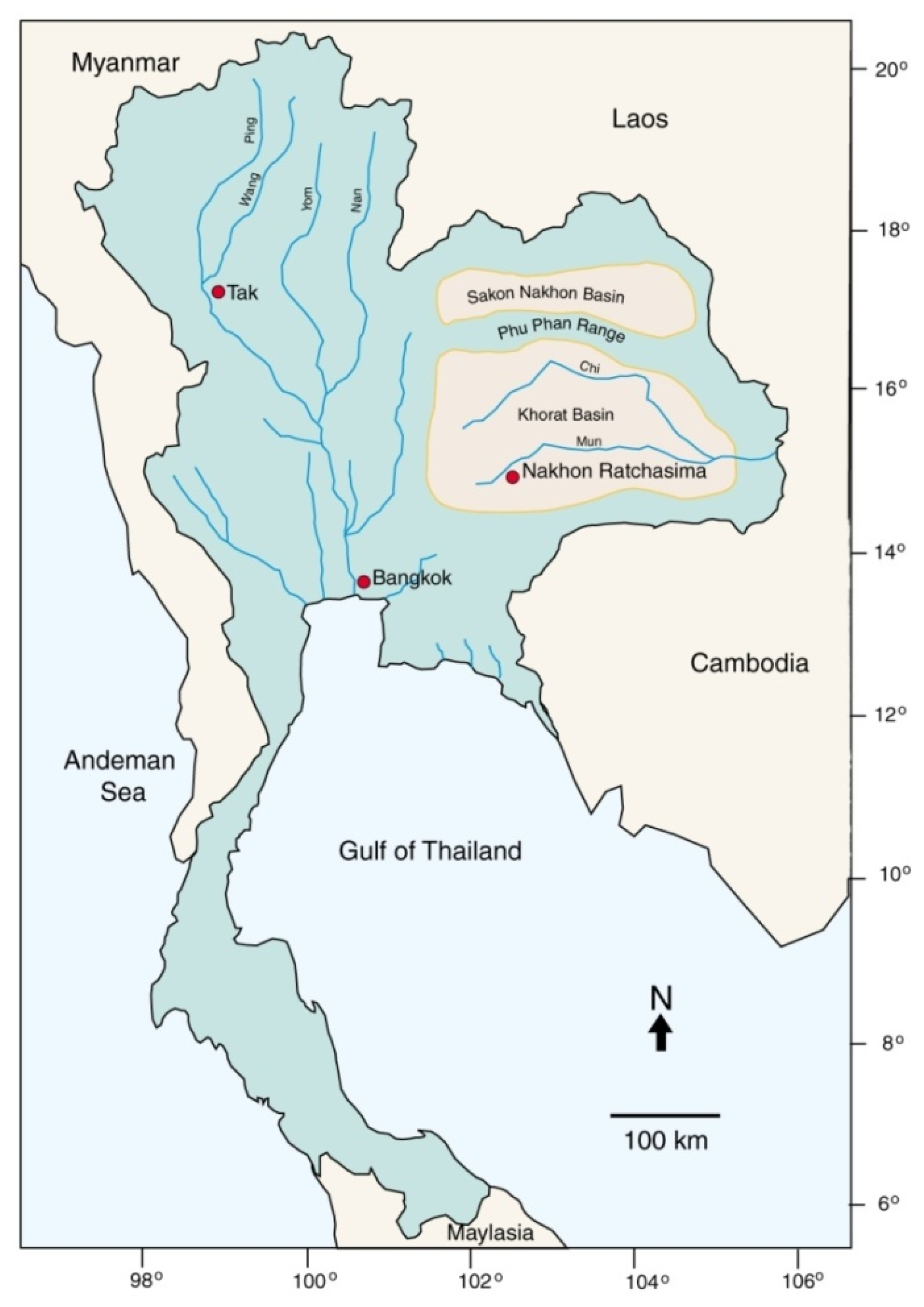
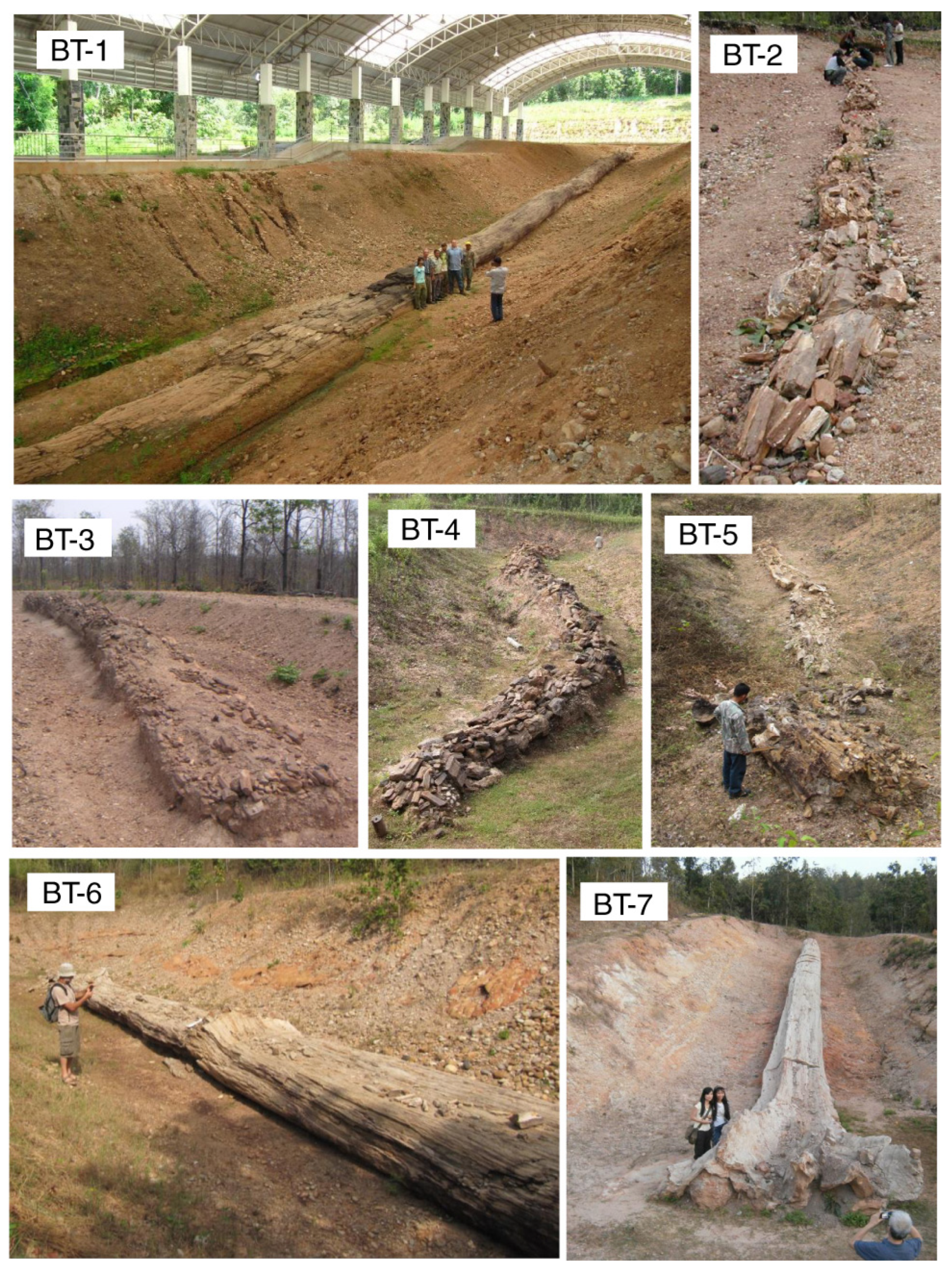
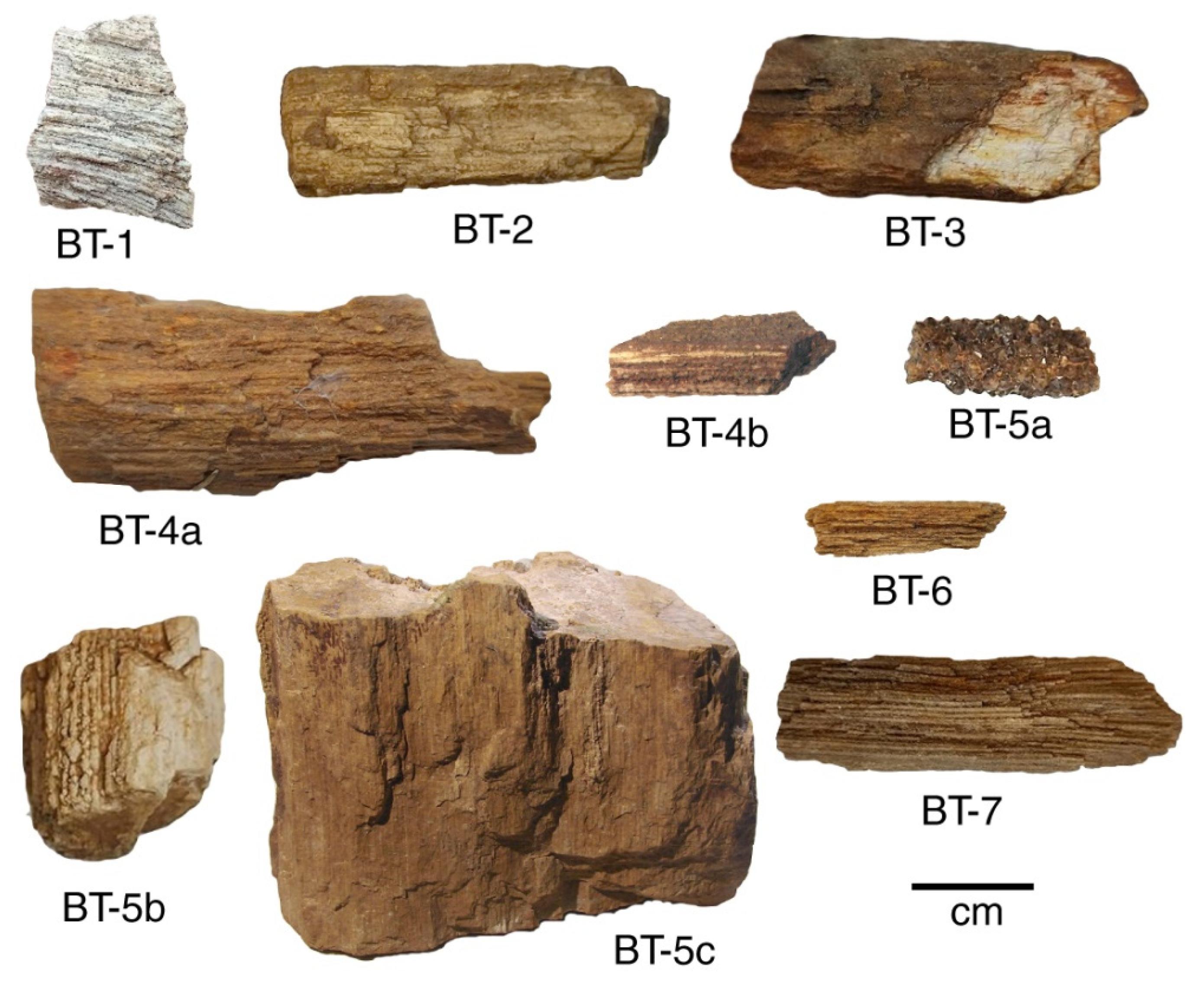
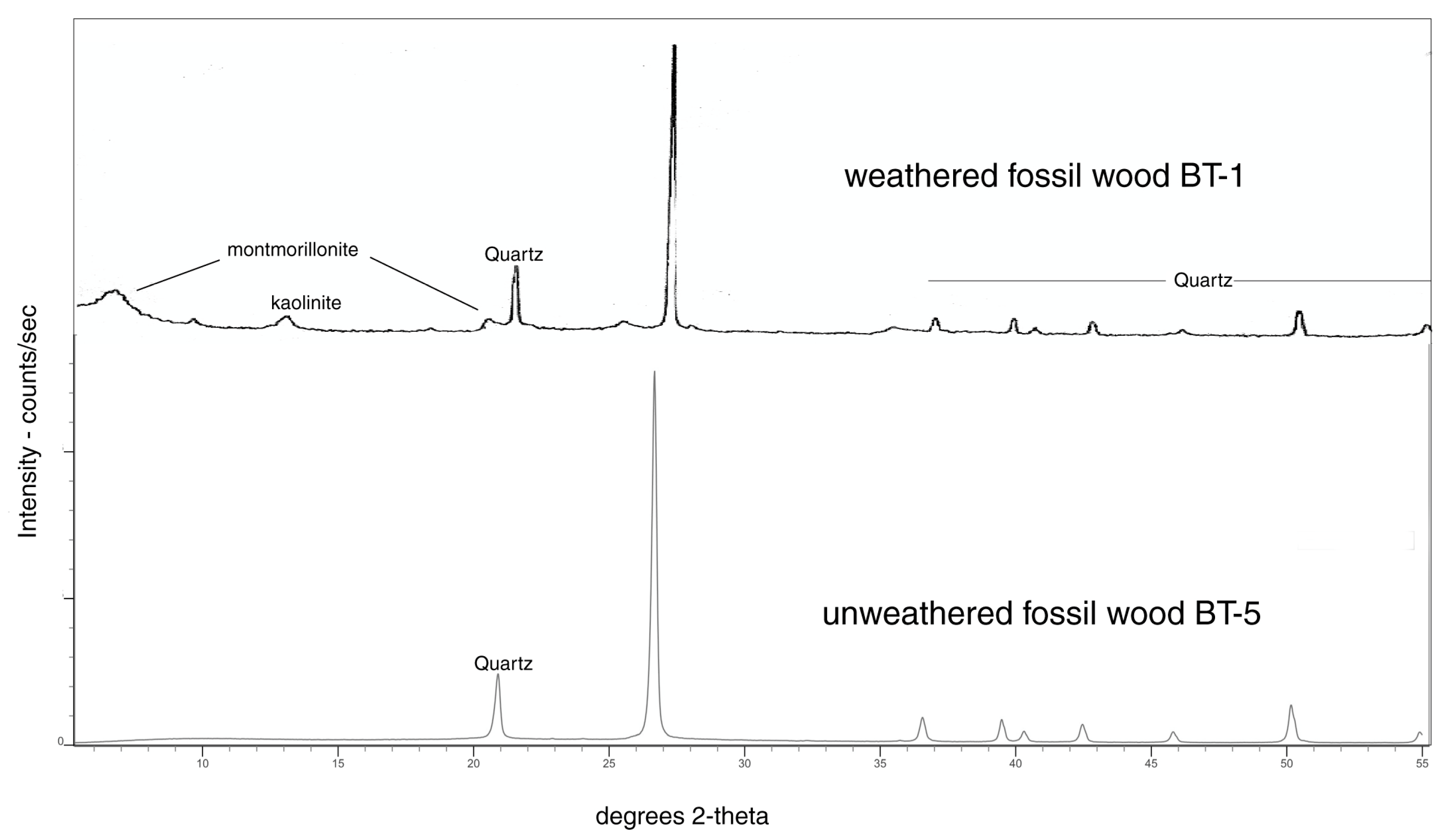
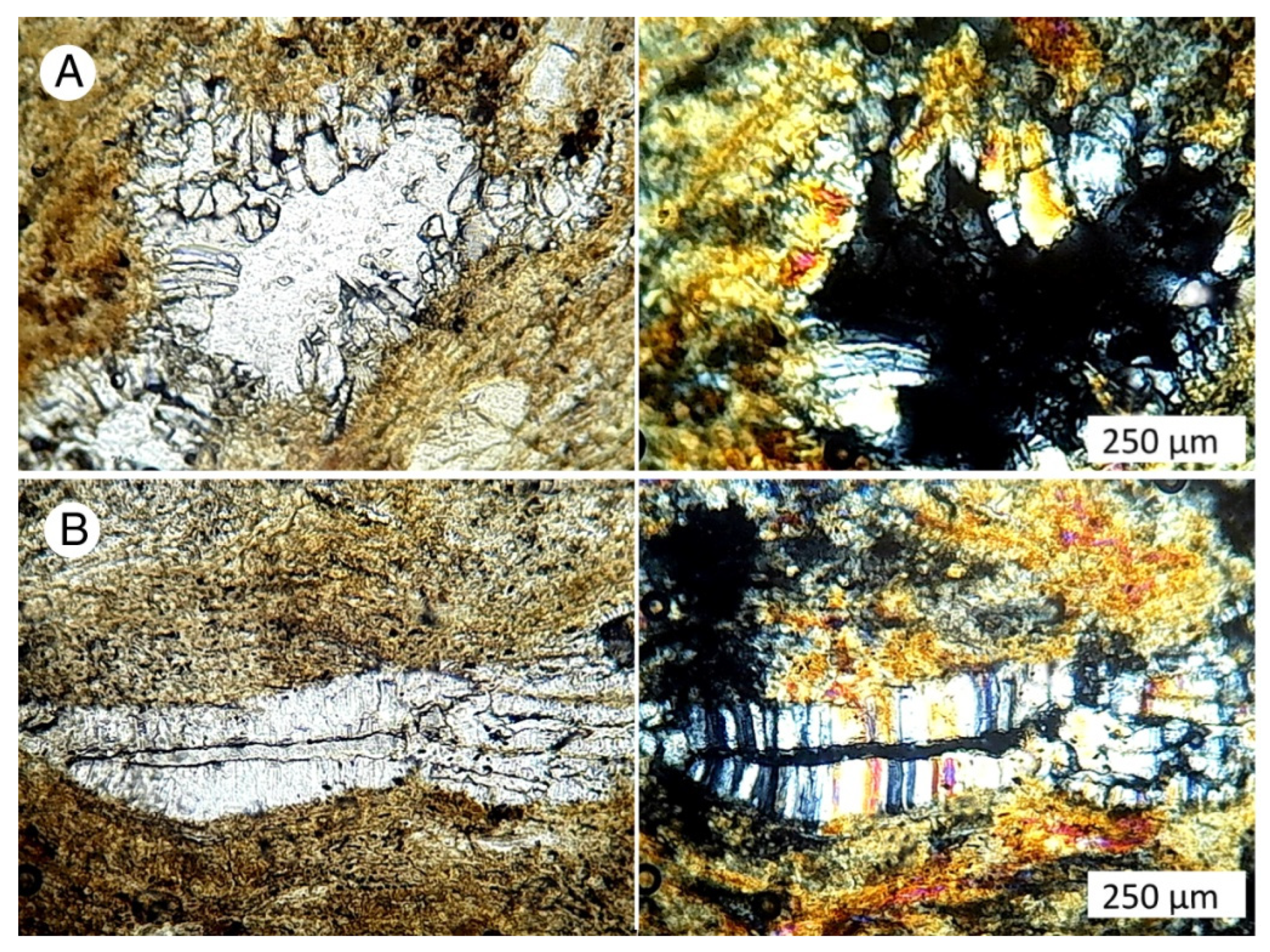
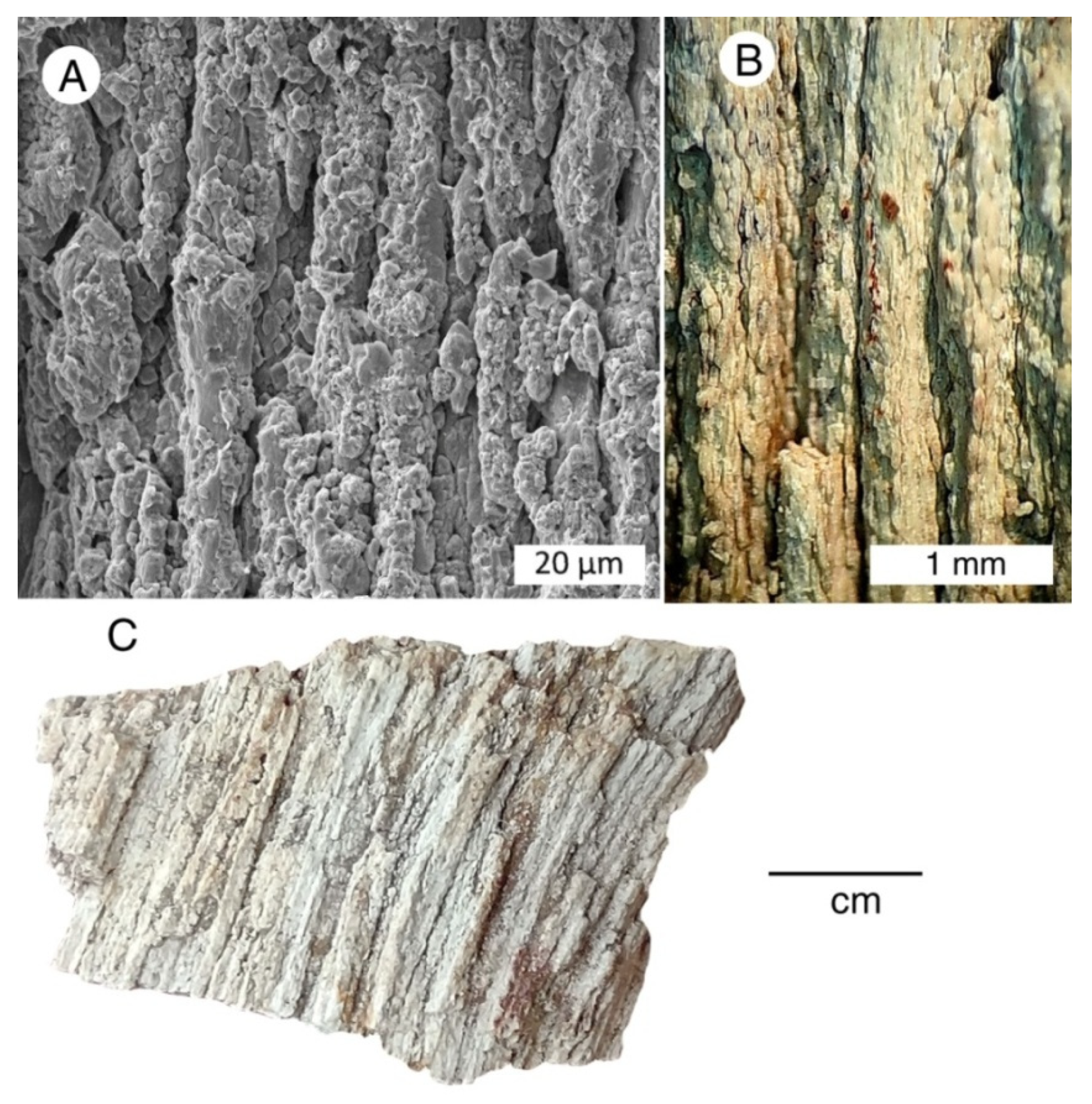
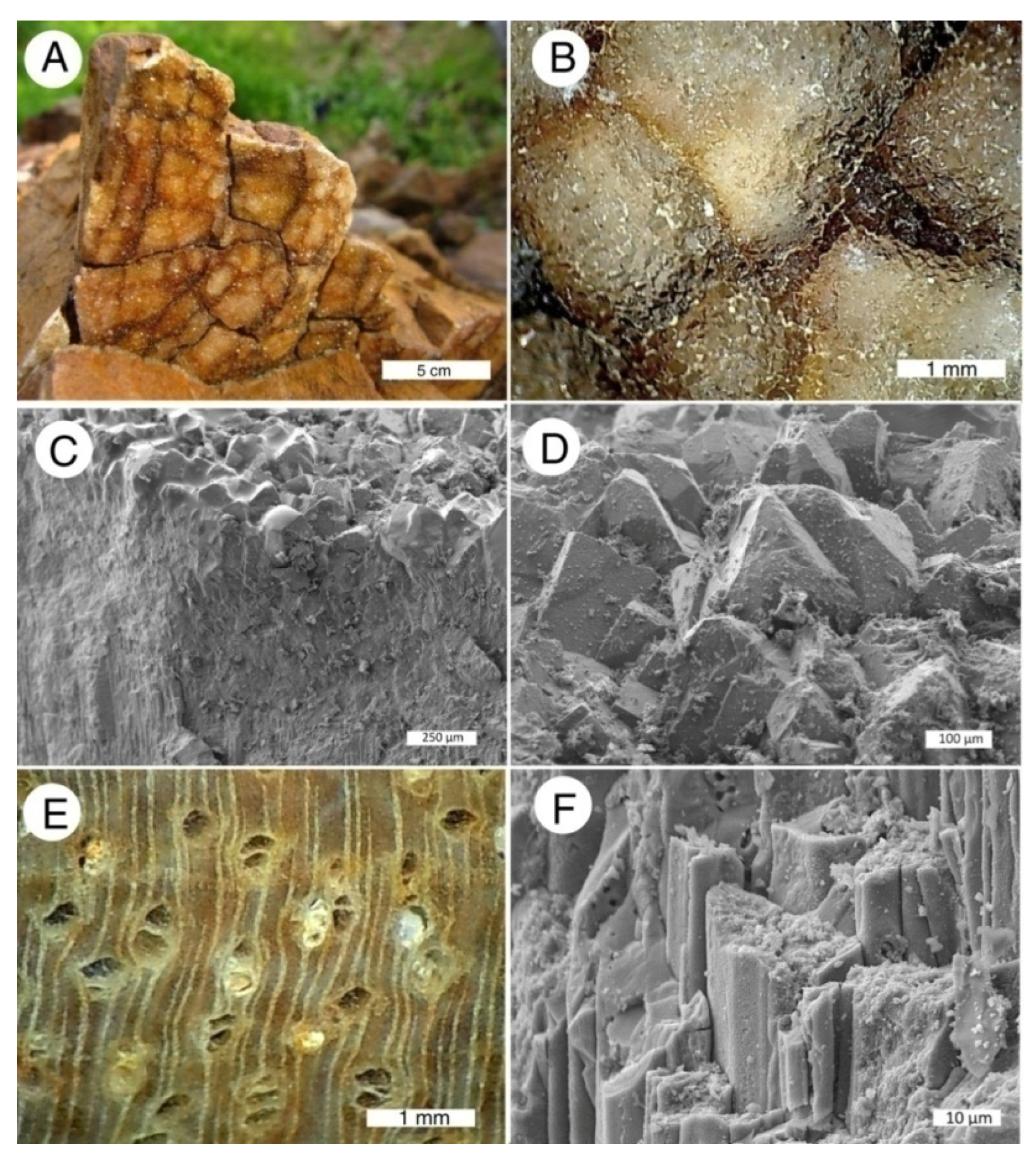

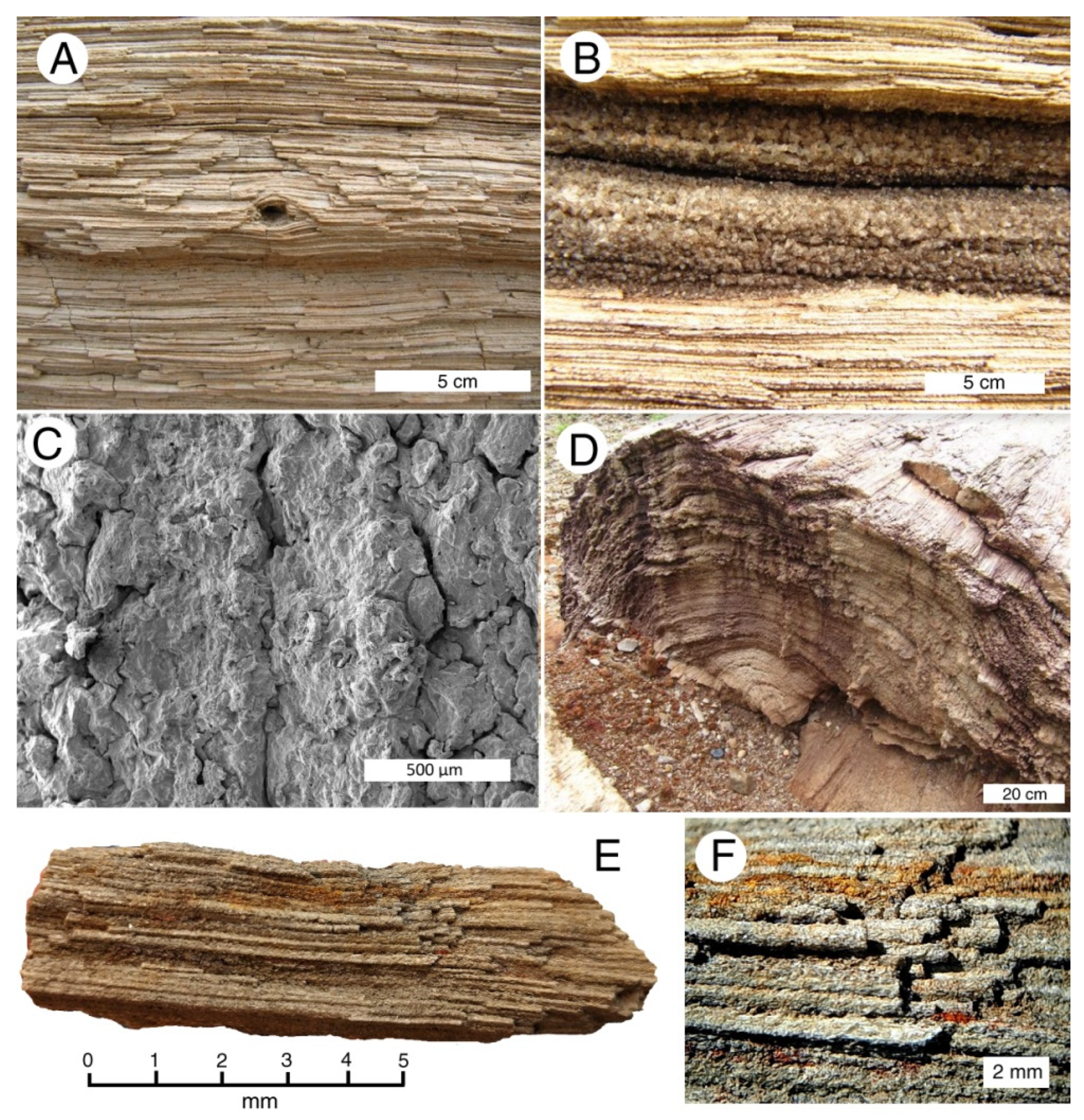
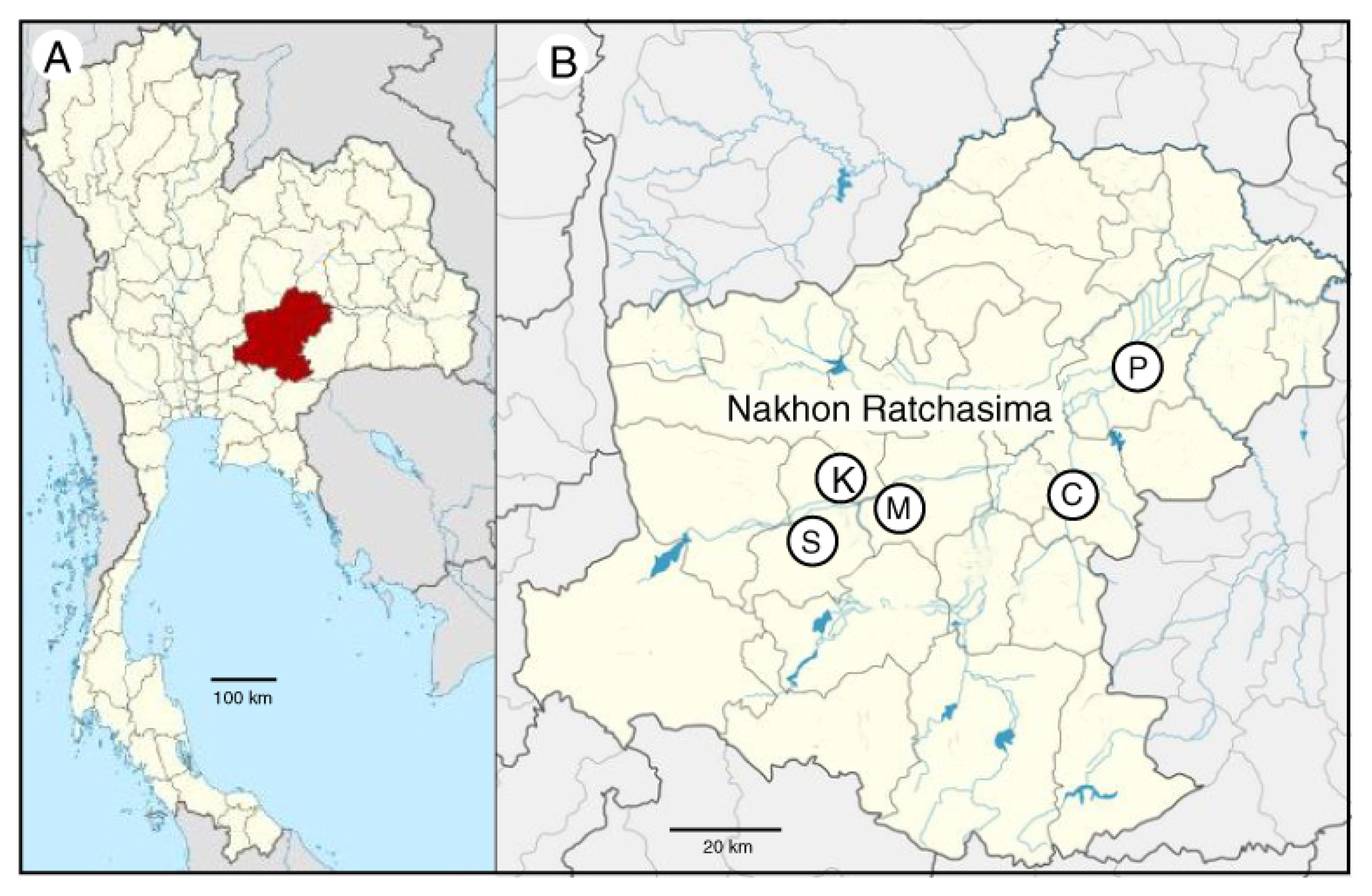
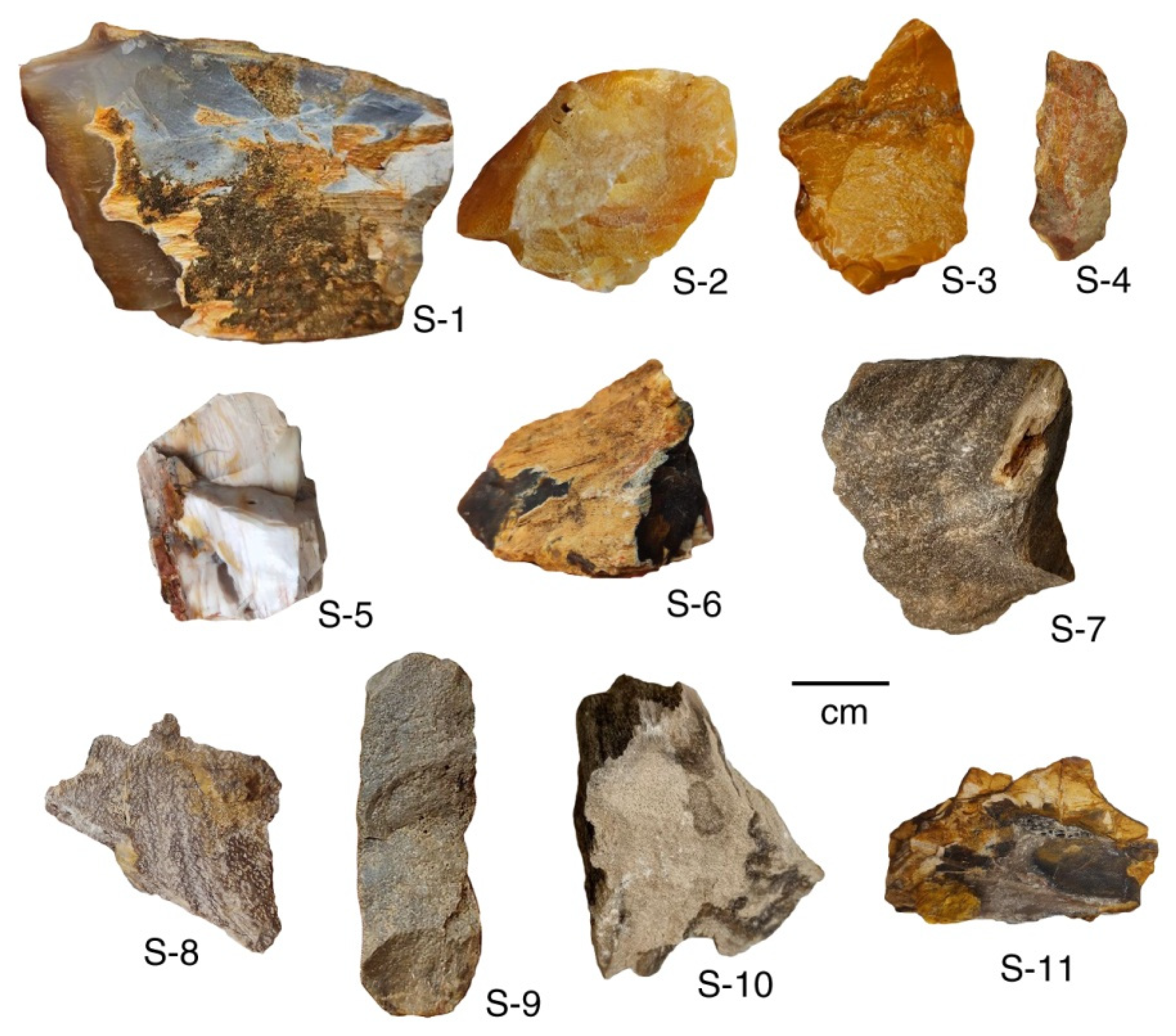

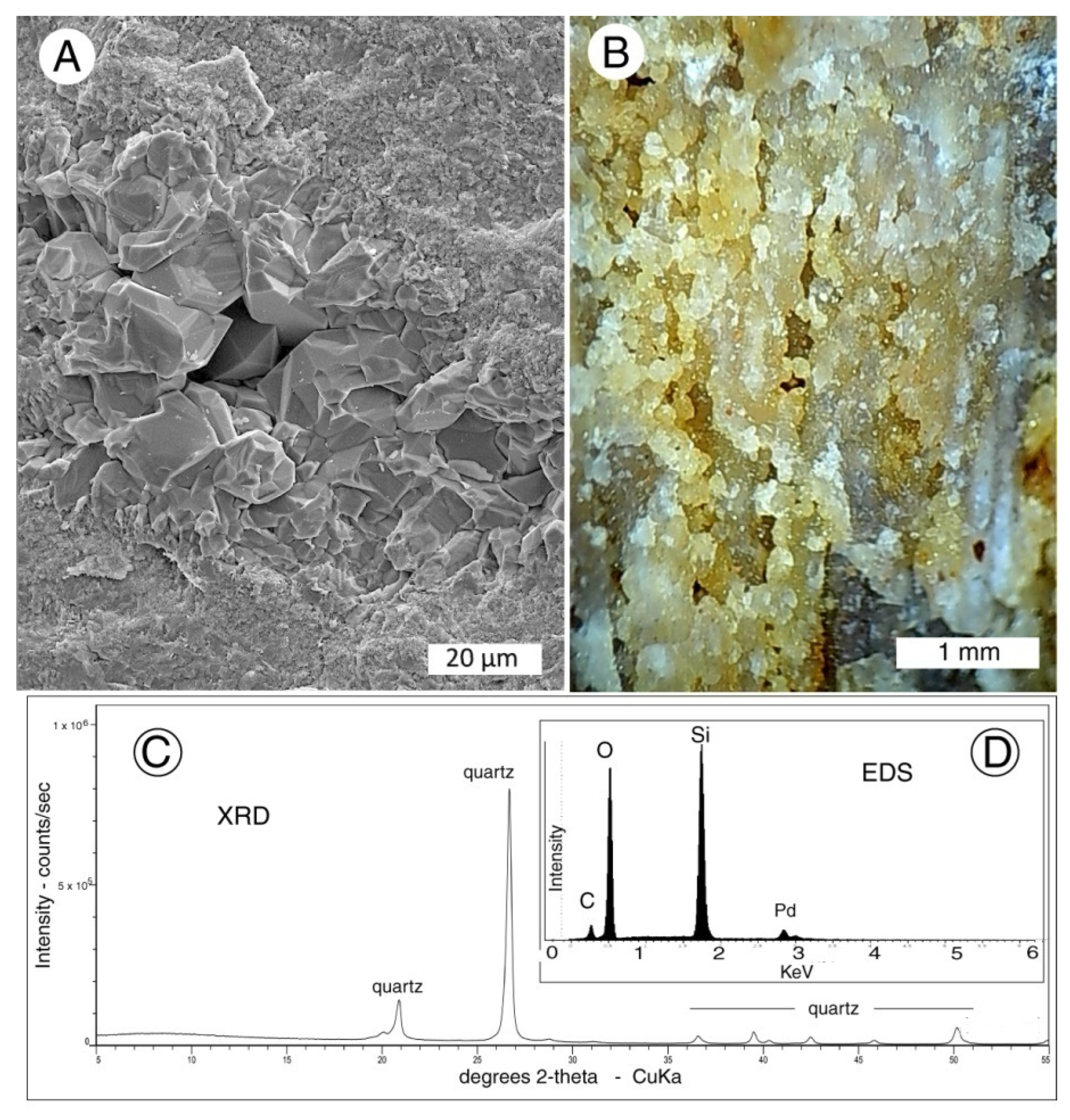
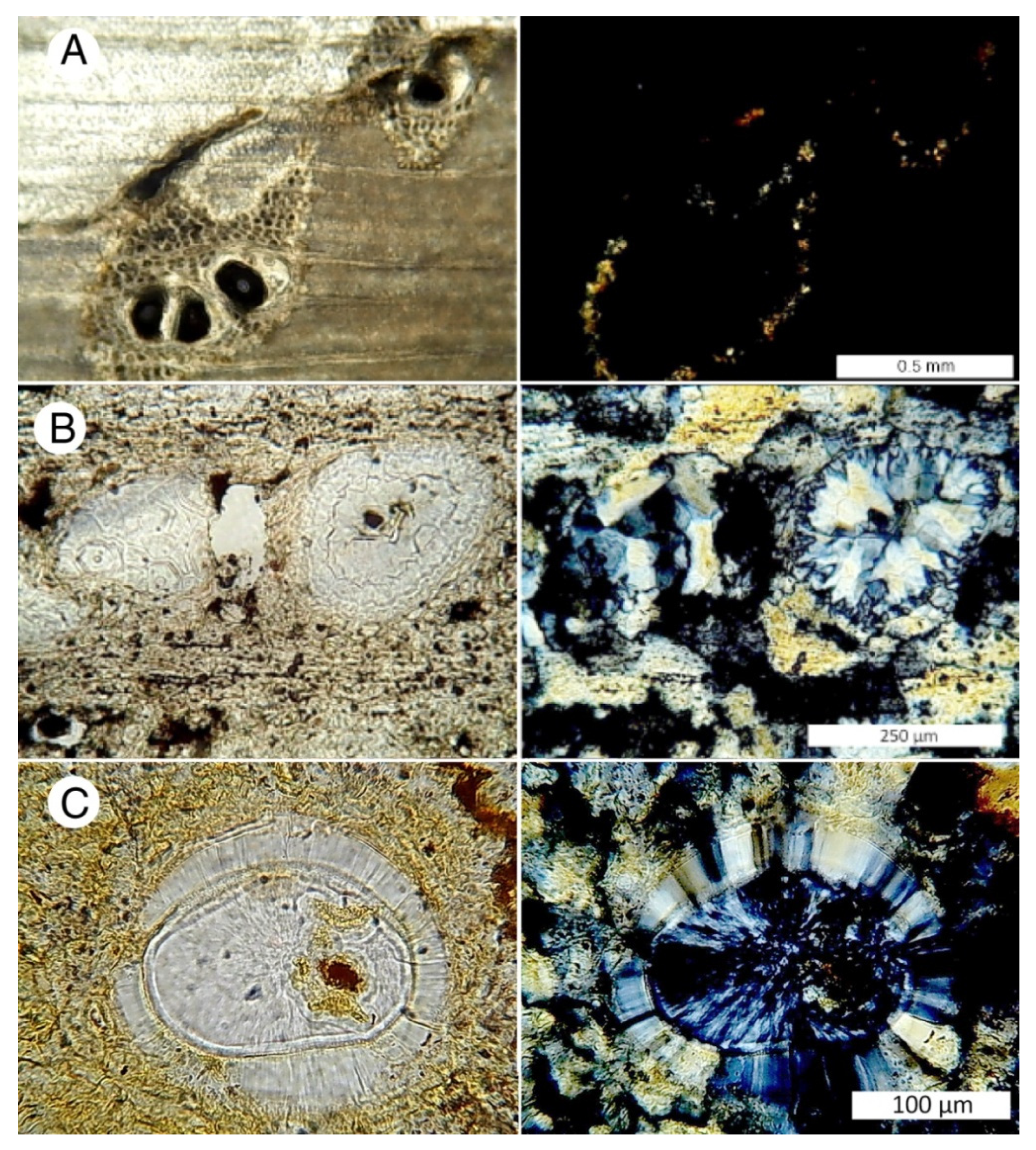
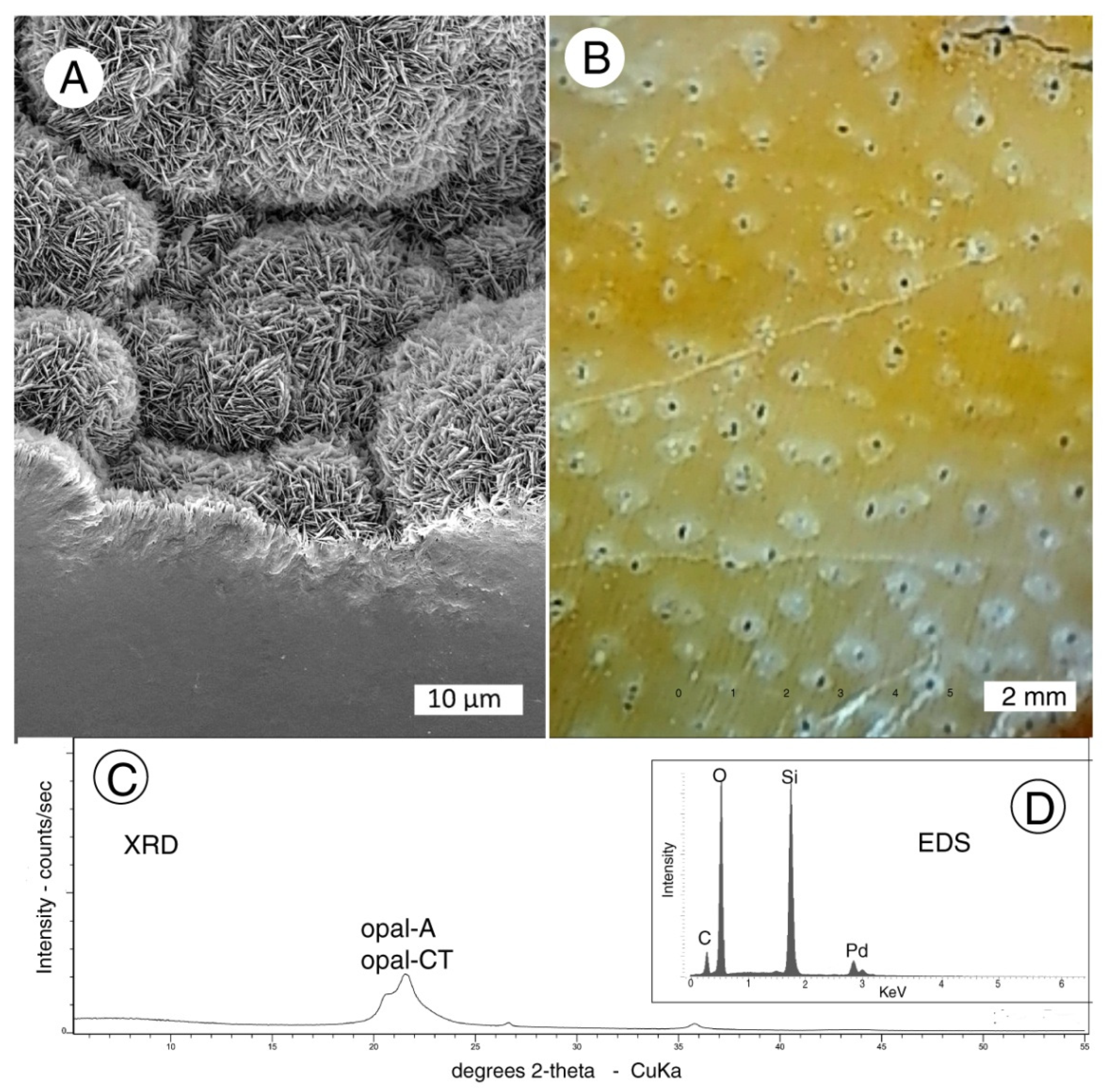
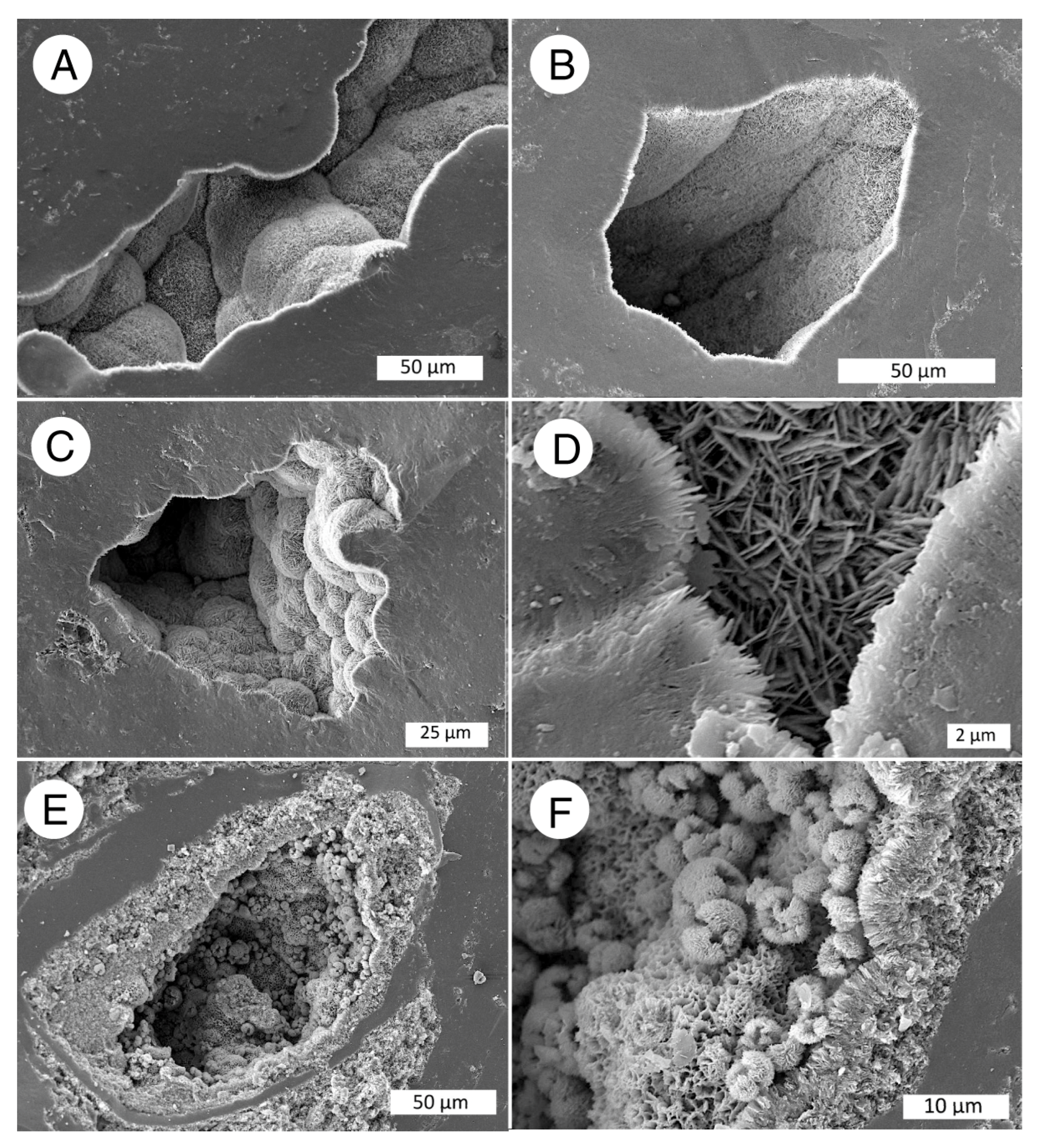
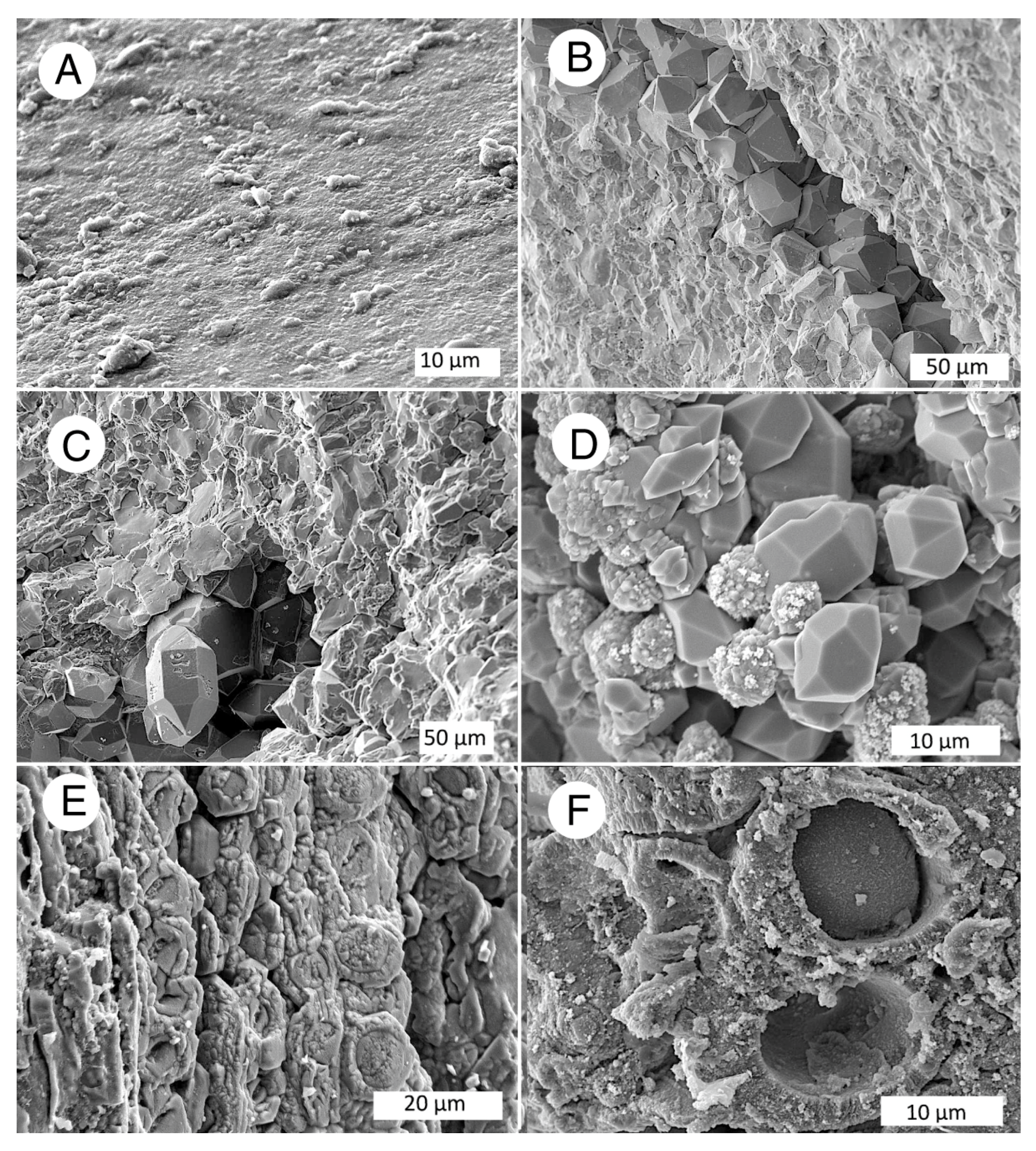
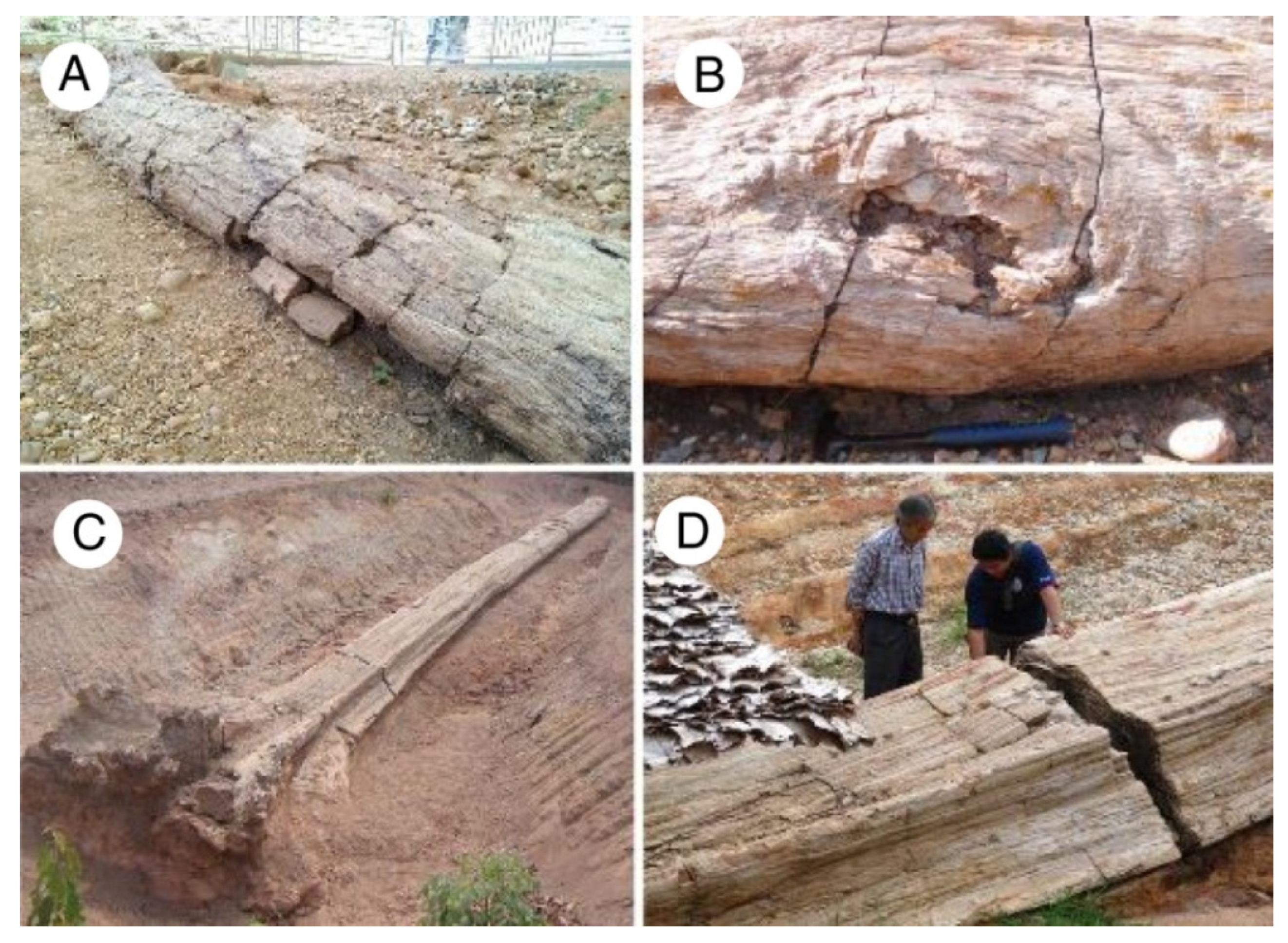
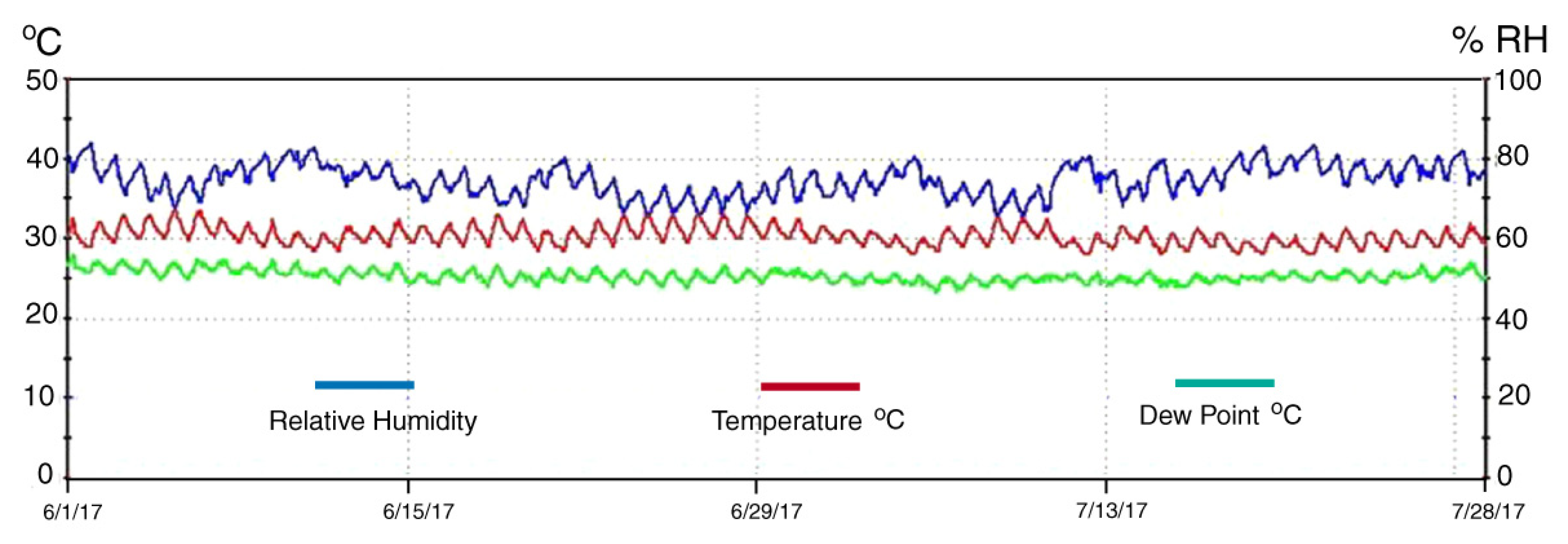

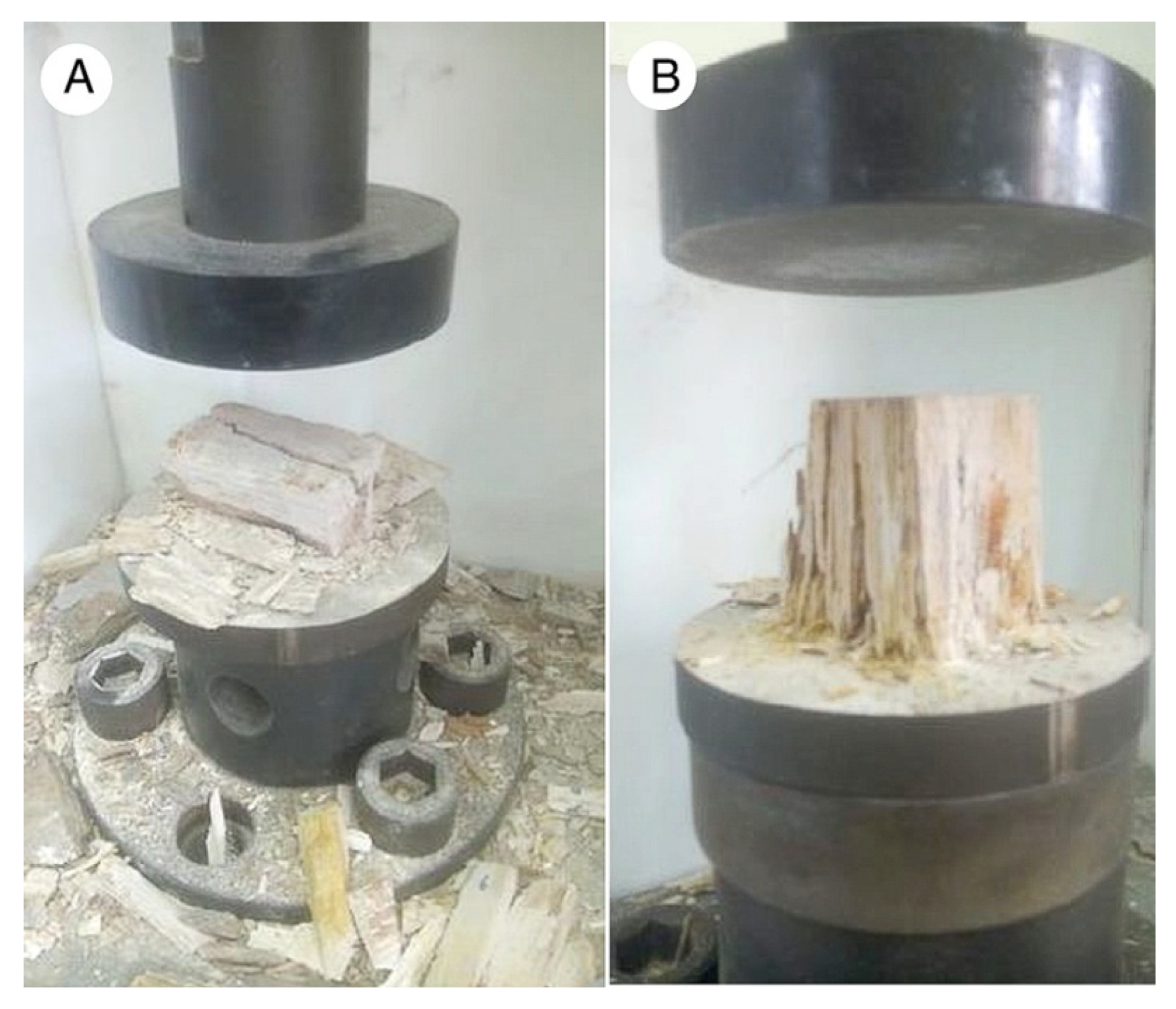

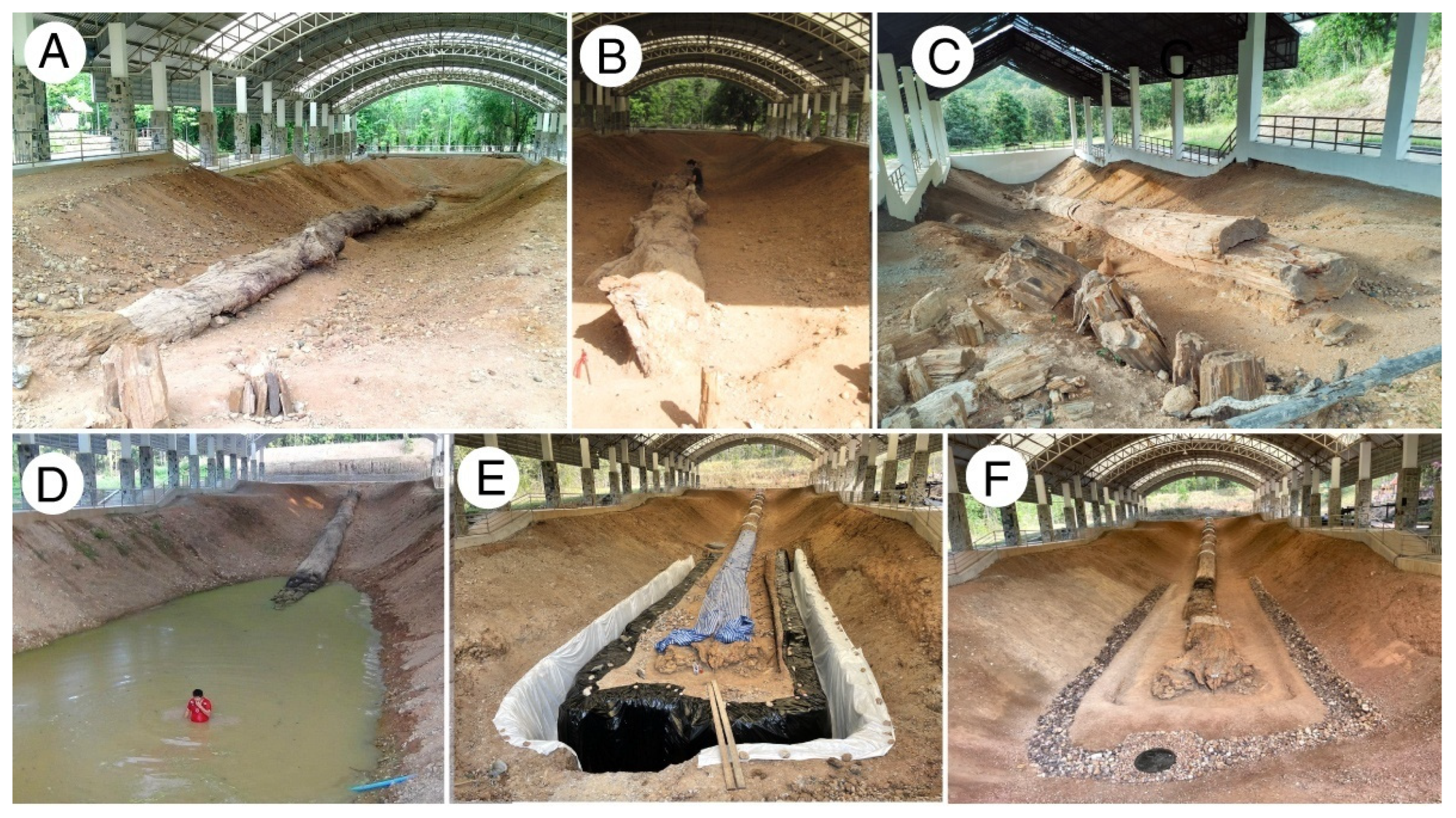
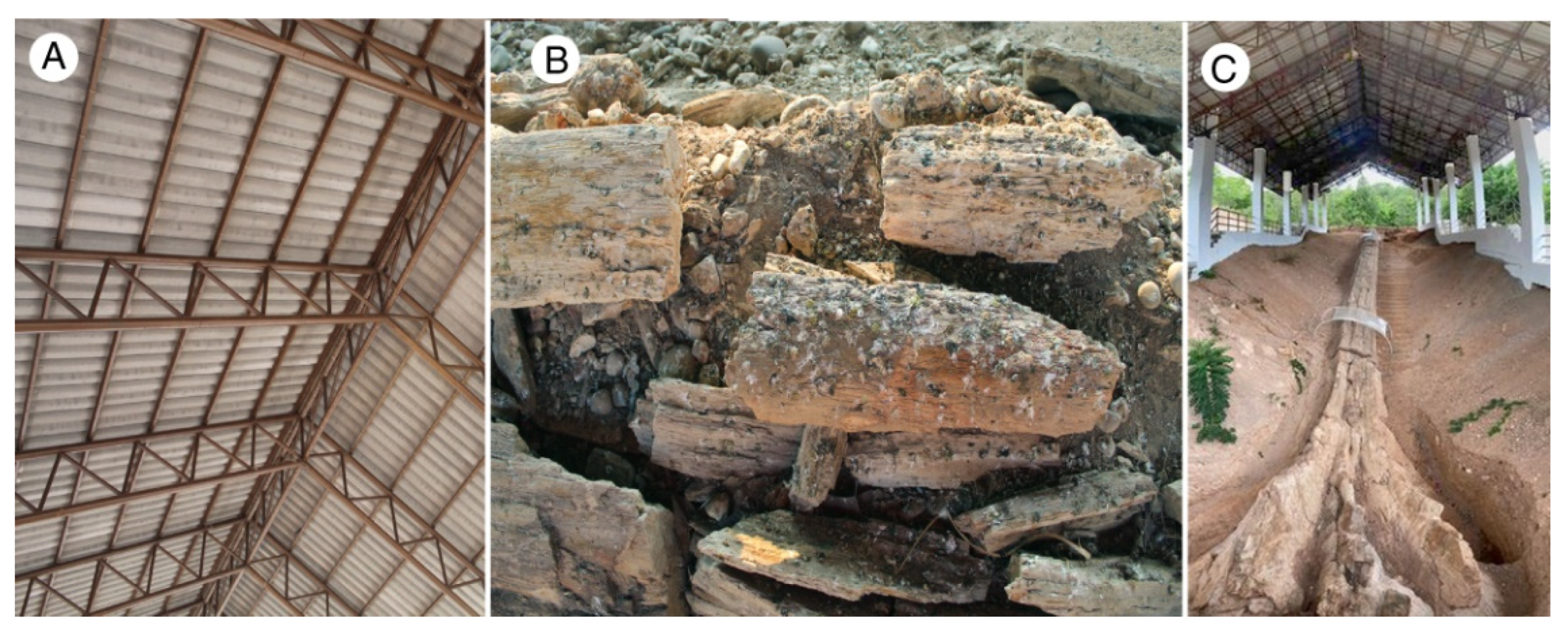
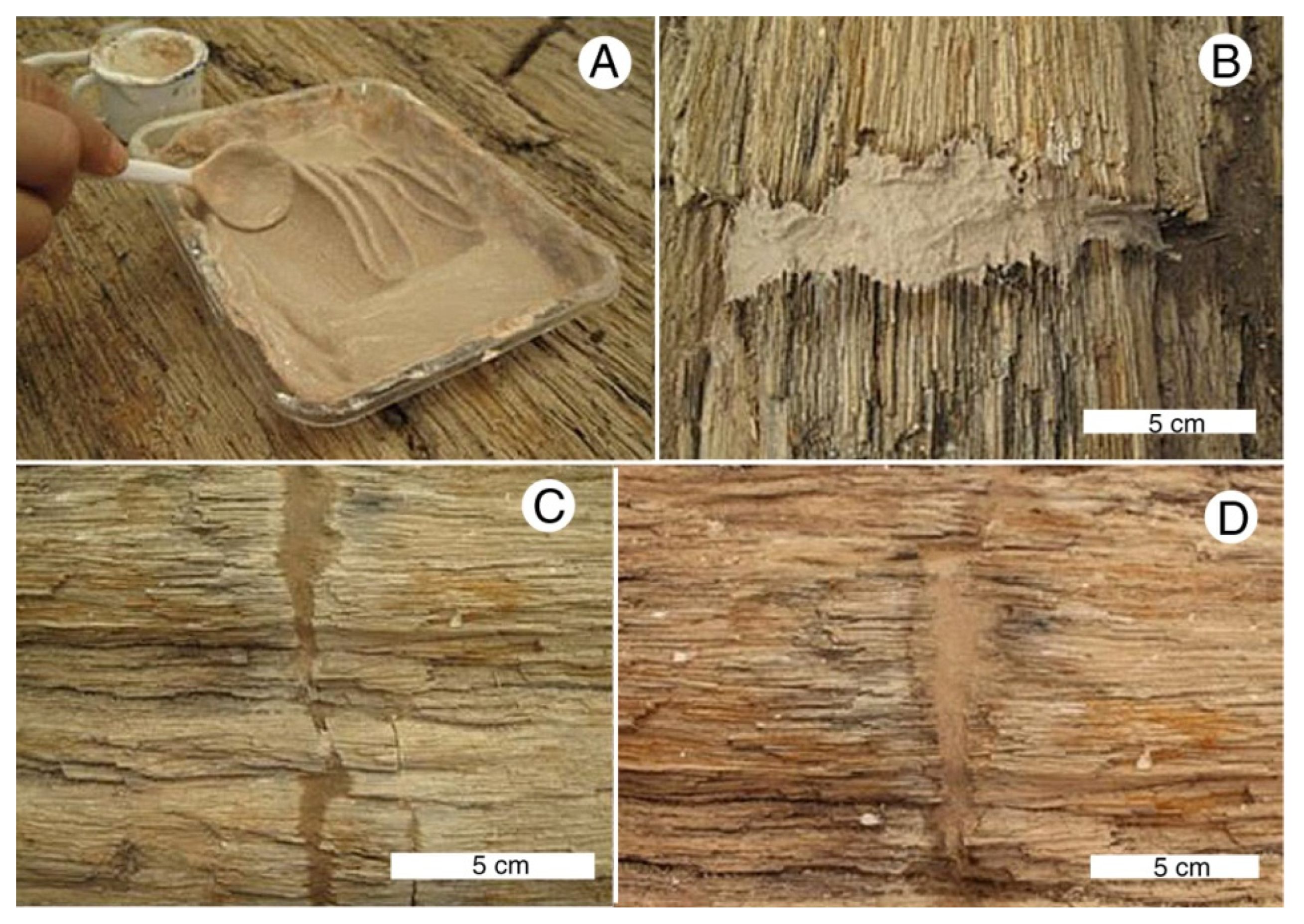
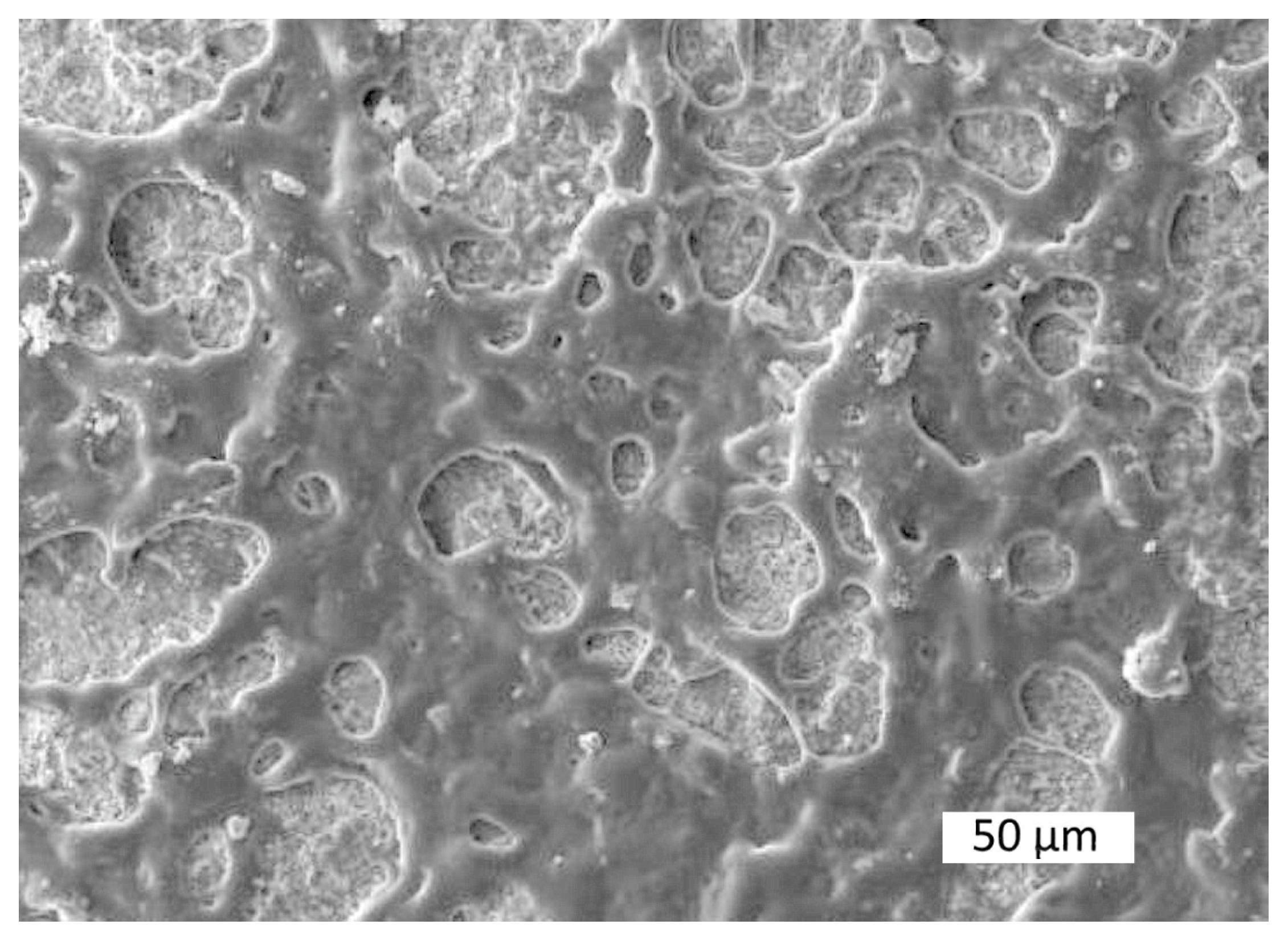
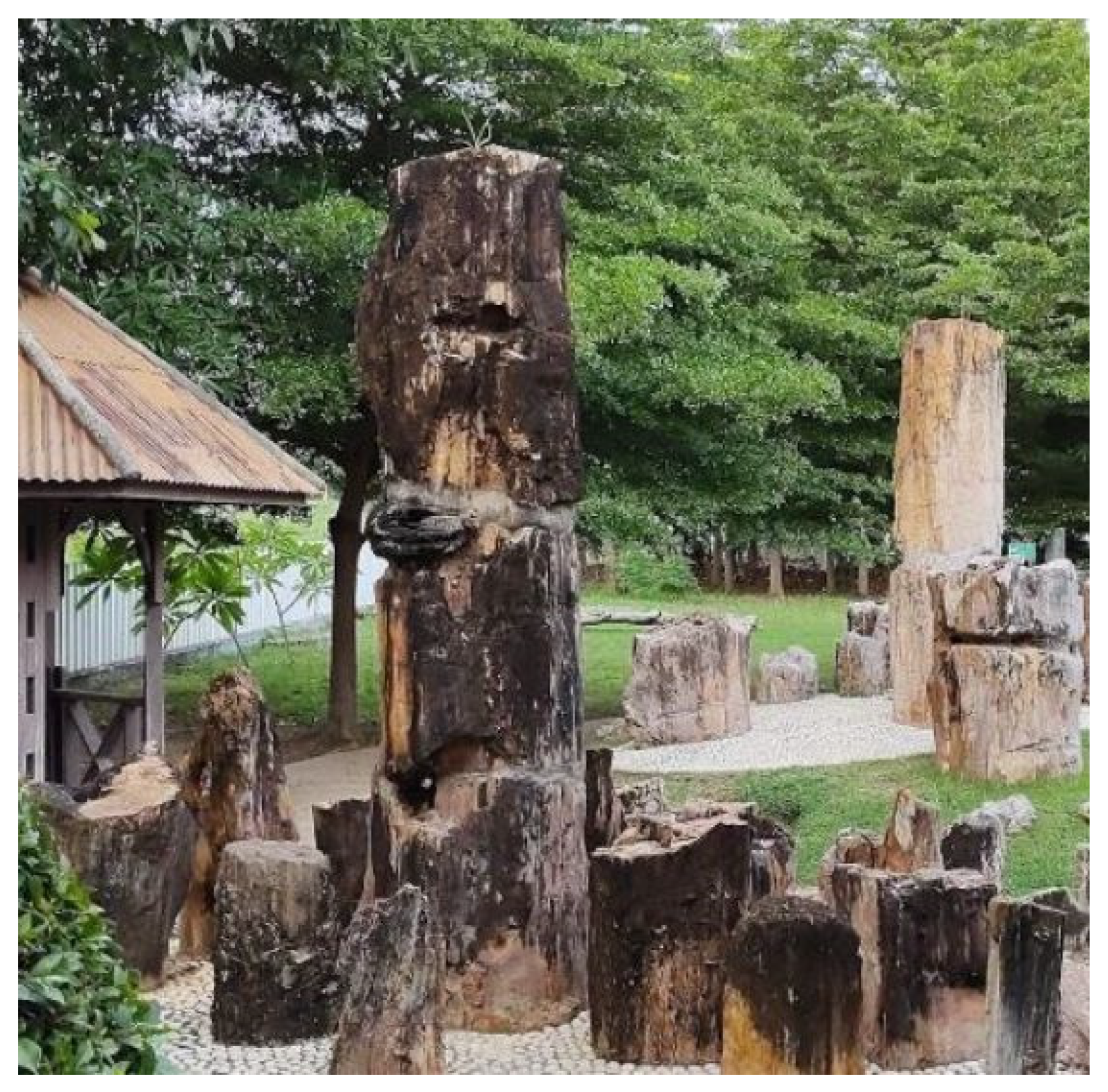


| Fossil Log | Specimen for Analysis | Density * gm/cm2 | Taxonomy | Length (m) | Diameter at Mid Length (m) | Current Preservation |
|---|---|---|---|---|---|---|
| BT-1 | BT1 | 2.33 | Koompassioxylon elegans | 69.7 | 1.8 | Mostly intact with cracks along the trunk. Some surface fragments, especially in lower middle region, Severe erosion of the butresss |
| BT-2 | BT-2 | 2.48 | Pahudioxylon cf. sahnii | 31.1 | 0.5 | Fragmented |
| BT-3 | BT-3 | 2.11 | K. elegans | 32.4 | 2.1 | Fragmented |
| BT4 | BT-4a | 2.31 | K. elegans | 44.2 | 1.4 | Fragmented |
| BT-4b | 2.36 | |||||
| BT-5 | BT-5a | 2.31 | Pahudioxylon cf. sahnii | 22.2 | 31.3 32.4 44.2 | Partially fragmented, especially in the middle zone. Buttress in large pieces with many cavities |
| BT-5b | 2.31 | |||||
| BT-5c | 2.42 | |||||
| BT-6 | BT-6 | 2.34 | K. elegans | 34.5 | Mostly intact, locally fragmented | |
| BT-7 | BT-7 | 2.38 | K. elegans | 38.7 | 22.2 | Mostly intact, but buttress partially collapsed and weathered |
| Mean density | 2.34 | |||||
| Specimen | Location | Density g/cm2 | XRD | Thin Section Mineralogy | |
|---|---|---|---|---|---|
| District | Subdistrict | ||||
| S-1 | Chakkarat | HinKhon | 2.59 | quartz | quartz, chalcedony |
| S-2 | Kham ThaleSo | Pong Daeng | 2.00 | opal-CT | opal A, opal-CT |
| S-3 | Mueang Nakhon Ratchasima | Suranaree | 1.99 | opal-CT | opal-A, minor opal-CT |
| S-4 | Mueang Nakhon Ratchasima | Suranaree | 2.10 | opal-CT | opal-A, minor opal-CT |
| S-5 | Mueang Nakhon Ratchasima | Suranaree | 2.09 | opal-CT | opal A, minor opal-CT |
| S-6 | Chakkarat | HinKhon | 2.56 | quartz | quartz |
| S-7 | Mueang Nakhon Ratchasima | Suranaree | 2.59 | quartz | quartz, minor chalcedony |
| S-8 | Mueang KhonKaen | Sawathi | 2.33 | quartz | quartz |
| S-9 | Sung Noen | Ma Kha | 2.56 | quartz | quartz, chalcedony |
| S-10 | Mueang Nakhom Ratchasima | NongRawiang | 2.45 | quartz | quartz |
| S-11 | Phimai | RangkaYai | 2.46 | quartz | quartz, minor chalcedony |
| Sample | pH | Conductivity (μS) | Salinity (ppm) |
|---|---|---|---|
| Unweathered wood | |||
| BT-1 | 6 | 91 | 60 |
| BT-1 | 6 | 174 | 86 |
| BT-1 | 6 | 121 | 80 |
| BT-2 | 5 | 80 | 40 |
| BT-3 | 5 | 75 | 35 |
| BT-4 | 5 | 34 | 16 |
| BT-5 | 5 | 35 | 20 |
| BT-6 | 5 | 70 | 34 |
| BT-7 | 5 | 50 | 29 |
| Mean | 5.3 | 81 | 44 |
| Weathered wood | |||
| BT-1 | 5 | 164 | 110 |
| BT-1 | 5 | 199 | 101 |
| Soil | |||
| Near BT-1 | 5 | 304 | 153 |
| Near BT-1 | 5 | 358 | 148 |
| Near BT-1 | 5 | 112 | 50 |
| Near BT-4 | 5 | 322 | 162 |
| Mean | 5 | 274 | 128 |
Publisher’s Note: MDPI stays neutral with regard to jurisdictional claims in published maps and institutional affiliations. |
© 2022 by the authors. Licensee MDPI, Basel, Switzerland. This article is an open access article distributed under the terms and conditions of the Creative Commons Attribution (CC BY) license (https://creativecommons.org/licenses/by/4.0/).
Share and Cite
Mustoe, G.; Aranyanark, C.; Boonchai, N.; Jintasakul, P. A New Look at Cenozoic Fossil Wood from Thailand. Geosciences 2022, 12, 291. https://doi.org/10.3390/geosciences12080291
Mustoe G, Aranyanark C, Boonchai N, Jintasakul P. A New Look at Cenozoic Fossil Wood from Thailand. Geosciences. 2022; 12(8):291. https://doi.org/10.3390/geosciences12080291
Chicago/Turabian StyleMustoe, George, Chiraporn Aranyanark, Nareerat Boonchai, and Pratueng Jintasakul. 2022. "A New Look at Cenozoic Fossil Wood from Thailand" Geosciences 12, no. 8: 291. https://doi.org/10.3390/geosciences12080291
APA StyleMustoe, G., Aranyanark, C., Boonchai, N., & Jintasakul, P. (2022). A New Look at Cenozoic Fossil Wood from Thailand. Geosciences, 12(8), 291. https://doi.org/10.3390/geosciences12080291







